Okay, after we’ve agreed upon “What’s not” supposed to be in PadThai, let’s see what’s hot. In this episode I’m going to give you the recipe and ingredients with which I make my Pad Thai.
Ingredients for 4 portions
1) The Sauce (Can be made in advance)
1.1) Tamarind pulp 1/4 cup
1.2) Coconut palm sugar 1/4 cup
1.3) Fish sauce 1/4 cup
Tip: mixing tamarind pulp and palm sugar over low heat will help soften the palm sugar, then turn off the heat before you add the fish sauce, so your whole house would not be “deodorized” with the fish sauce flavor. Otherwise, you are simply mixing the ingredients together.
Aways prepare the “sauce” first? I’ve heard a lot of people say to make PadThai you need to make the sauce ahead of time. It’s not a bad idea, but you can also make the Pad Thai without making your sauce first. The street vendors usually make the sauce ahead so they can make their PadThai fast and consistent. The advantage of making sauce in advance is you can take your sweet time, adjusting the taste to your preference.
There is another reason why you would want to make the Pad Thai sauce before hand. In making Pad Thai, you have four main foundation ingredients, three condiments, noodles, two protein options, and two vegetables. That’s a total of 12 ingredients (not counting the oil) going in apan that’s sitting over a full blast fire. It makes your life so much easier to combine the three condiments together. That eliminates three unnecessary steps, which would please Frank B. Gilbreth, Sr. but also gives the Pad Thai in the pan less chance to be burned while you’re adjusting the taste.
The Pad Thai street vendors in the old time didn’t make the sauce ahead, but they had their perfect measuring spoons for each of their condiments to control the consistency of their dishes. Since they weren’t competing for speed, they did just fine. My childhood memory buying PadThai was I had to wait and watch the merchant make my Pad Thai order right there in front of me, and the way to tell the good Pad Thai vendor was to look for a long line, because the good vendors made no more than three orders at a time, so the customers had to wait.
The ingredients aren’t written in stone, so they can be substituted for. These are the recommended choices for substitution.
Coconut palm sugar is not that hard to find anymore, Amazon is selling them, but if you have a hard time, you can use brown sugar.
Fish sauce can be substituted with soy sauce for the vegetarian, preferably mushroom soy sauce. Please do not use Kikkoman. If you really can’t find fish sauce but want to use it, try anchovies mixed with sea salt.
Tamarind pulp can be replaced with vinegar. I used balsamic vinegar when I made this dish in Italy once and it came out pretty good. It gave a pleasant flavor that was quite unique and not that far off from tamarind pulp, but I felt like I had wasted the aged-in-oak-barrels-for-30-years balsamic vinegar the moment I combined it with the stinky fish sauce!
Mix the three ingredients without heat. The portion ratio is 1:1:1 as a start, then you need to taste the mixture and fine tune the balance. Each ingredient always come in a different strength so you have to taste the mixture every time you make it. The right sauce is a balanced mixture of salty, sour, and sweet. I like to lead with saltiness, following with sour and then a finish of sweetness, because at the point of serving the dish you will get a wedge of lime and a pile of granulated sugar on the side to adjust the final taste. So you can keep both the sweet and sour flavors mild for now.
You can either mix them together and use them that day or make a batch of sauce ahead of the time and store it in the refrigerator. If you have leftover sauce from a batch after cooking, you should combine it all together and heat the mixture to a full boil and then store it in a clean jar.
I don’t suggest boiling the sauce until it thickens because you don’t really need thick sauce unless you need to save the storage space. If you make a thick sauce, you will have to add water when you toss the sauce in with the noodles anyway, so why waste time and energy?
Once you have got the sauce ready then we’re ready to prep the other sections of the ingredients. Remember, I told you four foundation ingredients, three condiments, one noodle, two proteins (optional), two vegetables and three seasonings. This is how I remember ALL the ingredients without turning the page in my notes or any recipe book.
Tip: The following ingredients need to be chopped into small pieces.
2.1) Chopped shallots 1/4 cup, 1 tablespoon for each serving portion.
Alternatively, you can use very strong-flavored onion such as a big red onion along with one teaspoon of chopped garlic if you absolutely can’t find shallots. I have to add a little bit of garlic because onion can’t give the pungent aroma the way I like. I don’t normally use garlic in my Pad Thai though, but you can use it if you prefer.
2.2) Chopped salted preserved radishes or turnips 1/4 cup, 1 tablespoon for each portion (Chi Po Kem).
This is an important ingredient. I only allow the sweet preserves of the same root vegetable, radish or turnip (Chi Po Wan) to be the substitution. I gave you two names, turnip and radish, because they use both names on the packages. You shouldn’t be using pickle carrots, cucumber, okra or mustard greens. You can order them from these online stores Importfood.com, Grocery Thai.com Without this ingredient, you would be making “Farang” (foreigner) Pad Thai.
2.3) Pressed tofu cut into a thin pieces (1/4” x 1/4” x 1/2”) approximately 1/2 cup, 2 tablespoons for each portion (add more for the vegetarian).
Pressed Tofu is the firmest of all tofu. It will withstand vigorous stirring and still come out whole and chewy. Most firm tofu will break apart in the process. However, If you can’t find it you can get firm tofu and you can press it yourself by following this simple method of How to Press Tofu by about.com.
2.4) Salted small dried shrimps, soaked in water until softened 1/4 cup, 1 tablespoon for each portion (skip this for the vegetarians).
I use medium-sized dried shrimp. Their size is about 3/8” in diameter. I don’t use the small size because I can’t find small shrimps that have already been shelled. If you can’t find medium or small sized shrimp, you can chop or grind the bigger size.
This might present an interesting opportunity for a substitution because it’s there for the umami taste. I used dried salted abalone once when I made this dish in Hong-Kong. It came out very delicious but dried abalone is quite expensive. You are welcome to try other substitutions such as salted dried cuttle fish or salted dried scallop, but I’m not so sure about salted dried fish because it might give too much fishy taste. If you try one, let me know how’s your Pad Thai turns out.
Thin rice noodles, also called Rice Sticks or Banh Pho soaked in cold water until they soften, but not too soft, and loosely packed, about 1-2 cup per portion (depend on how much carb you’re willing to eat)
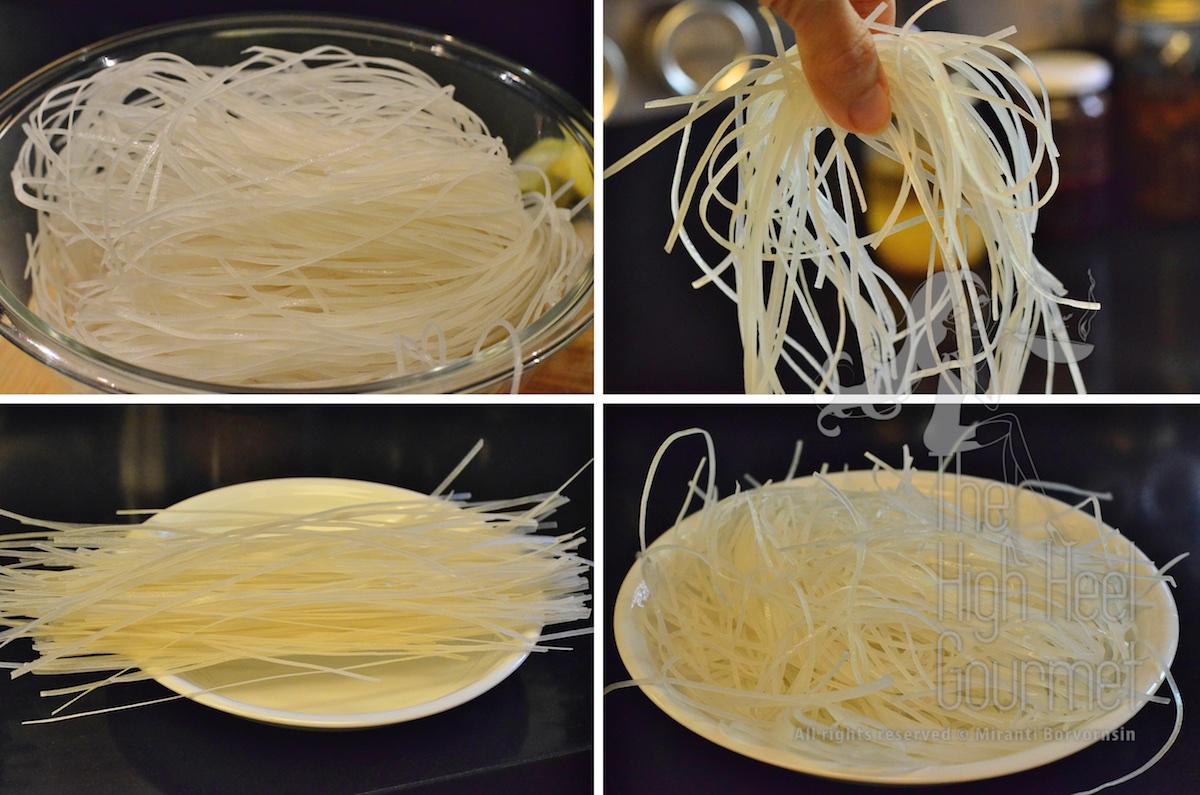
TOP LEFT: fresh noodles TOP RIGHT: “pliable” stage that you would achieve after soaking the dried noodles in cold water but you will get this stage from fresh noodles right outside of the bag so no need to soak the fresh noodles, BOTTOM LEFT: dry Chantaboon noodles BOTTOM RIGHT: Chantaboon noodles after soaking in water
If you have an Asian market near by and want to use fresh rice noodles, soak them in cold water anyway but for a shorter period. You want your noodles to be “pliable”. If they’re too soft they will turn into mush in the wok. You want your PadThai to be dry and the noodles soft but stretchy, not soft and mushy.
Actually there are more noodle choices than you might think. The rice stick, banh pho or “Sen-lek” in Thai is the most well known one. Then there is “glass noodle” or cellophane noodle, the clear noodles made with mung bean flour is a very good choice of noodle as well since they absorb the flavor really well. I made Pad Thai with Shirataki noodle, that contain no food calories by themselves. You can also make Pad Thai without noodles at all.
This time we’re focusing on the traditional Pad Thai so we will be using the small rice sticks. I will show you the many variations of PadThai later on in the next episode.
4.1) 4 eggs, one for each portion
The original Pad Thai never had major meat as part of the ingredients because the Thais are not the big meat eaters. Their diet consists of mostly vegetables and carbs, with a little bit of protein, mainly from eggs, small fishes, shrimps, and crabs. They might eat chicken or pork here and there, but beef only once in a long while. They are not big into killing large animals. The first protein introduced to the dish is of course, an egg.
Early on even the egg was an option—after all, the dish already had tofu and dried shrimps. The merchant would normally ask every customer “You want it with or without egg?” I remember not liking the Pad Thai with egg at all, but the “adults” would want me to eat it with egg. So it was such a treat when they had no time to go buy food for me and gave me money to buy my own Pad Thai instead. I would hold the money tight in my hand, go to my favorite Pad Thai vendor at the open market by myself and order my Pad Thai “without egg”. That generally made me felt like an adult even as I saved the rest of the money. (The one without egg would cost less, of course.) To then buy a popsicle like a child with the saved money didn’t really ruin my “adulthood” feeling the least bit. In fact, it was the proper way to celebrate my temporary maturity.
4.2) Fresh shrimps, medium size, peeled and deveined, about 6-8 per each serving
Shrimp were introduced into Pad Thai not so long ago. I would say about twenty something years ago I started to see the “fancy” PadThai with fresh prawns show up in some restaurants’ menus. In general, Pad Thai was not a restaurant item. If one wanted to get an order of Pad Thai, one had to search the street vendors in a local open air market, order and sit down to eat on whatever flimsy, wobbly chair and sticky, unsanitary table they provided. You would be so lucky if you don’t have to share the table with strangers. If that’s not romantic enough, one can order the take home Pad Thai, wrapped in a piece of newspaper lined with banana leaves. Notwithstanding this, when restaurants attempted to “fancify” the street food, the street vendors started offering Pad Thai with an option of fresh shrimp too.
There is no such thing as “Chicken Pad Thai” or “Beef Pad Thai” served in Thailand. Well, they might serve them now but only in the areas populated with “Farang” (foreigners). Actually, to the Thais, that’s not only unheard of but also grosses them out. I don’t recommend it either unless you are allergic to shrimp.
5) Vegetables
5.1) Bean sprouts loosely packed, 1-2 cups for each portion, half of them for the wok fry and the rest to serve fresh with the finished Pad Thai.
You can’t miss out on the bean sprouts. If you can’t find bean sprouts, don’t even consider making Pad Thai. I’m THAT serious. Mung bean sprouts only, NO soy bean sprouts, radish sprouts, alfalfa sprouts or other kind of sprouts.
5.2) Garlic Chives cut the bottom half inch off each chive and discard. Then cut the next 3-4” from the bottom from each, and save them to serve fresh with the finished noodles. Then cut the flat leaves into 1-1/2” long pieces. You will need about 1/4 cup for each portion.
Don’t let me see green onion or scallions in your Pad Thai. Garlic chive has a flat leaf, and a flat, green stalk—if you can blow air into a hollow stem, that is, the green part of the stalk, you’ve got the wrong herb!
5.3) Other than those two vegetables, you can use banana blossoms (Hua Pli), Tiger Herbal or Asiatic Pennywort (Bai Bua Bok) all of them could be served with the finished Pad Thai.
6) Seasoning
I know, I know, it gets a little tedious. But you followed me this far. This is just the last touch. On the other hand, this last touch reflects the real Thai culture, which doesn’t standardize the taste when it comes to food. Everyone can tailor their dishes to their own liking with these seasonings.
6.1) Crushed peanuts 1 full tablespoon for each serving
6.2) Wedges of lime
6.3) Granulated sugar 1 teaspoon for each serving
6.4) Dried crushed chili pepper as much or as little as you need
Haaaa…I feel like I have written a novel, but I haven’t give you the most important part: how to make it.
Method
You would need a high-heat stove. If you have the electric stove, you won’t be able to make a good Pad Thai, despite the fact that you follow all the instructions I gave you precisely. Anyhow, there is a way to compensate—please read the tip for electric stoves at the end.
Tip: Remember, make only 1-2 portions at a time. DO NOT try to make more than that!
1) Heat a pan, or preferably a wok, over high heat, add about 1-2 tablespoons of vegetable oil and wait until it’s smoking.
2) Add the shallots and fry until they sizzle and release their aroma, no more than half a minute, if the wok is hot enough.
3) Add the three other foundation ingredients: salted turnip,
dried shrimps
and tofu,
all together, toss them around, keeping them moving. I call these “foundation” for a reason. They’re going to release the aroma that is necessary for the whole dish into the oil. Some of that will be absorbed by the tofu and some will be absorbed later by the noodles. Fry until the tofu changes color. You can add about a tablespoon of water if the ingredients get too dry.
4) Add the noodles
and then the sauce.You will need about 3-4 tablespoons of sauce.
Toss them quickly,
making sure that the sauce coats all the noodles. If the noodles are too dry or stick together, add a little water, one tablespoon at a time, and toss quickly to separate them. You shouldn’t have to use more than 2-3 tablespoons of water.
5) Push the noodles to one side of the wok, add another splash of oil, about another tablespoon,
wait until the oil gets hot at this point it’s only take seconds, then crack the egg and add directly in the hot oil,
scramble it a little
and then flip the noodles that you pushed to the side back over the egg, start counting from one to fifteen. If you count too fast, count to fifty. You want the egg to set before you push it around again or the egg would dissolved into a fishy mess. Also there is NO NEED TO SCRAMBLE THE EGG AHEAD OF THE TIME (Yes, I am shouting at you, so DON’T DO IT). Scramble the egg ahead of time like a rookie is just not authentic and the flavor wouldn’t blend well together, yucky!
6) While you wait for the egg to set, add the shrimps
and start tossing everything together again.
Cook until the shrimp get pink and curled. It shouldn’t take long.
7) Lower the heat, or turn off the heat if you are using cast iron wok, and add the garlic chives and bean sprouts,
toss them around, mixing them well with the noodles and all the other ingredients. The leftover heat will cook the vegetables and keep the noodles from overcooking. Toss them until the vegetables are soft.
8) Put the Pad Thai on the plate and serve with all the seasonings ON THE SIDE, together with more fresh bean sprouts and the garlic chives that you saved.
9) Now, rinse and repeat until you have servings for everyone.
If you’re using a non-stick wok or pan, you might not need to rinse but make sure that there is NOTHING left on the wok.
In the next episode I will show you the varietions of Pad Thai. Rest assured, I don’t mean “Chicken Pad Thai” or “Beef Pad Thai” indeed!
Tips for the electric stove user: Heat your stove with the wok or the pan on until it’s smoky, make sure that all ingredients are at room temperature so you when you add the ingredients, it won’t lower your wok temperature that much. Wait until the contents in the wok are hot before you add another ingredients.
The Pad Thai Trilogy has already been completed. It consisted of three parts.
Pad Thai Trilogy, Episode I: What’s not
this is the most important part of the Pad Thai Trilogy, Episode II: The “Authentic” recipe

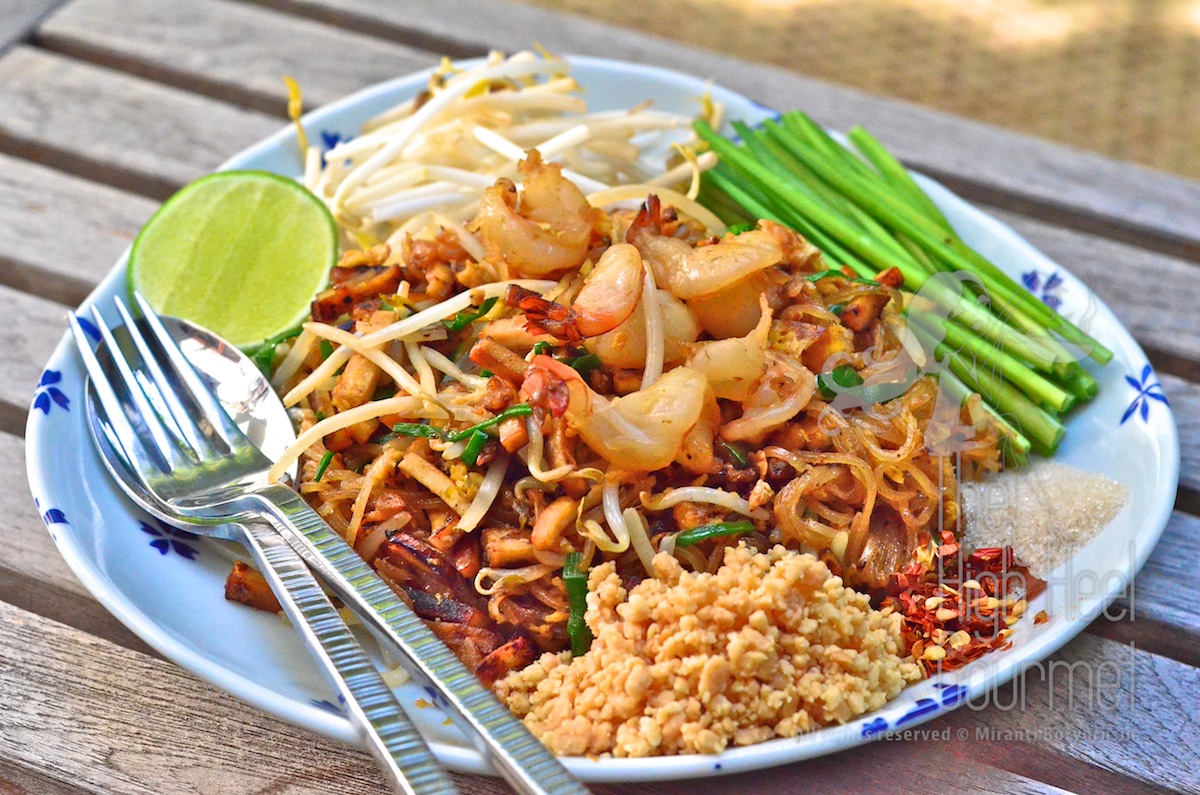
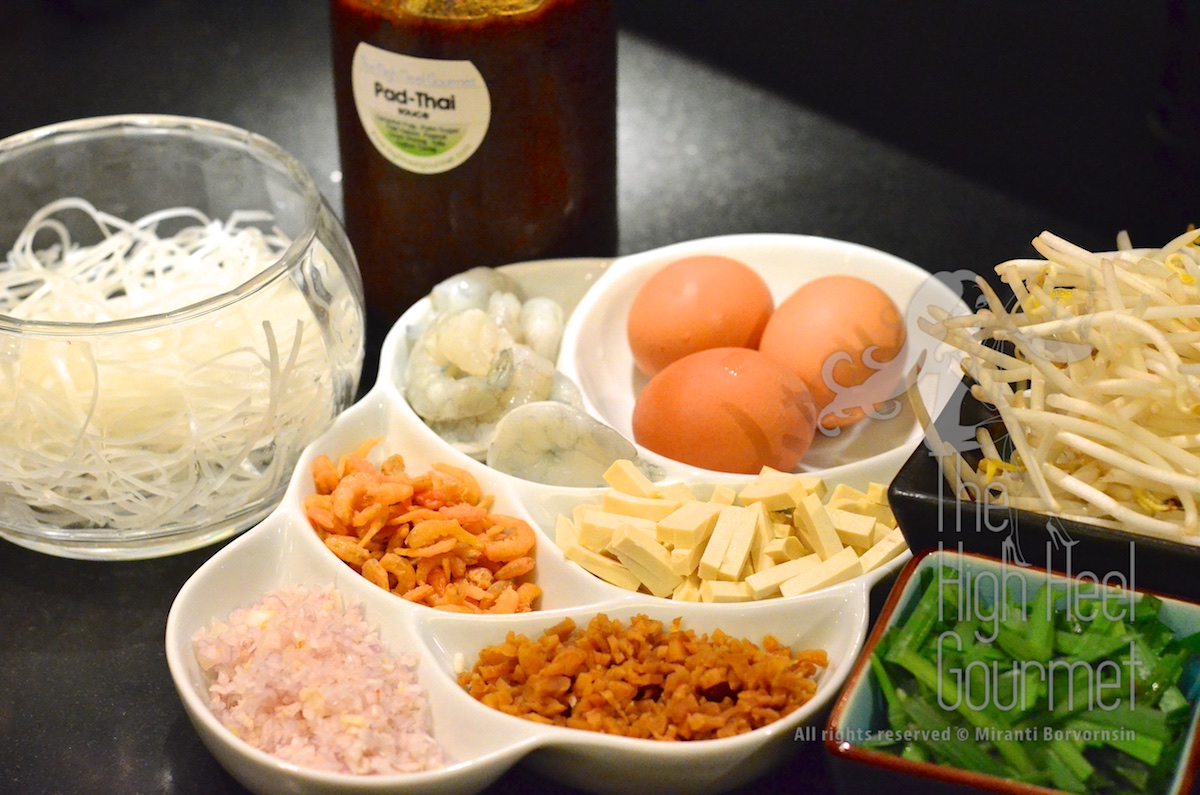
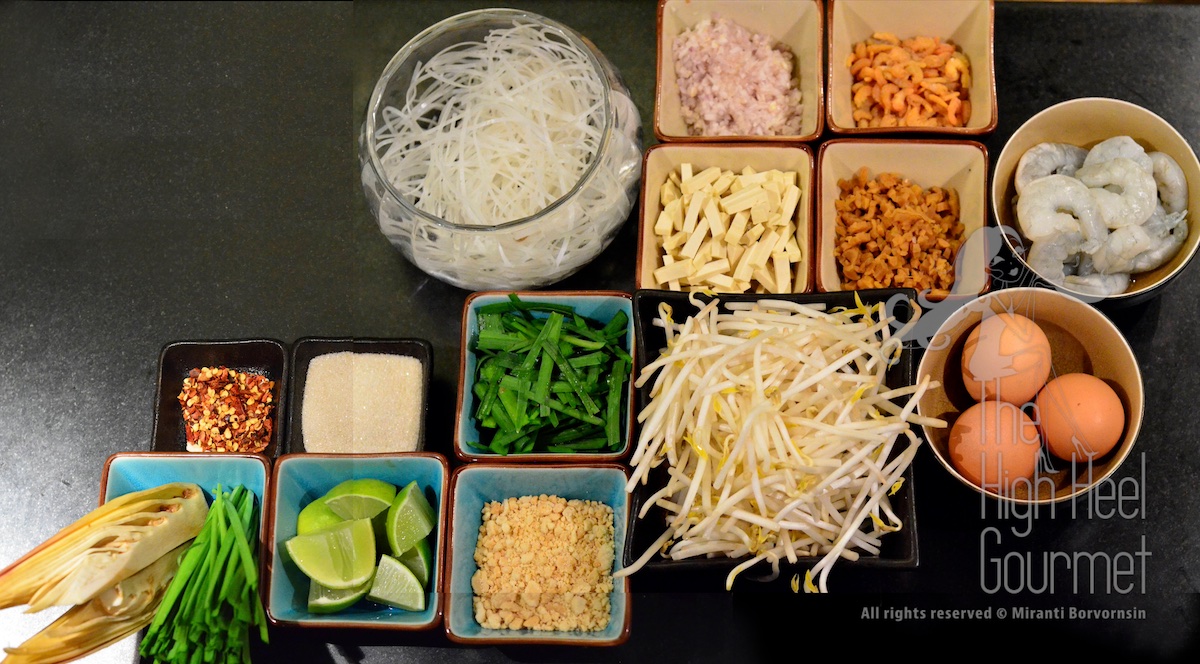
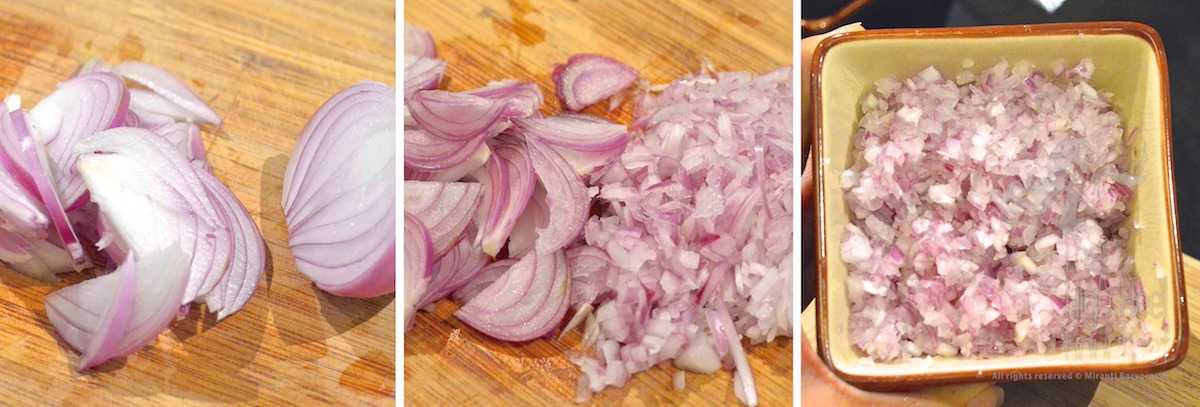
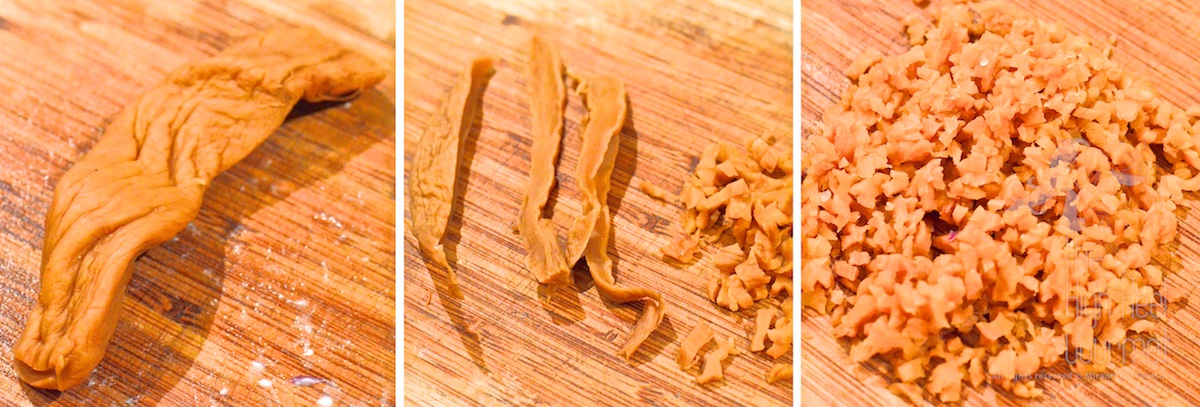
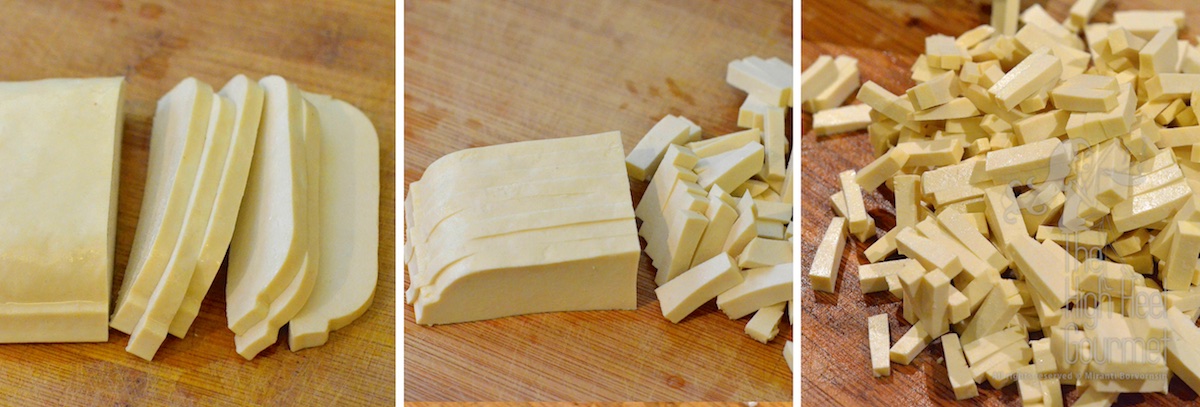
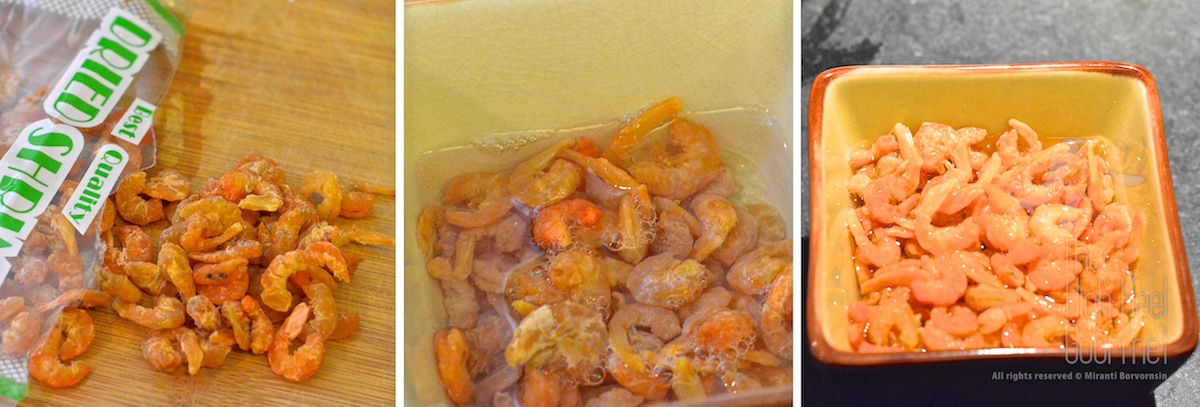
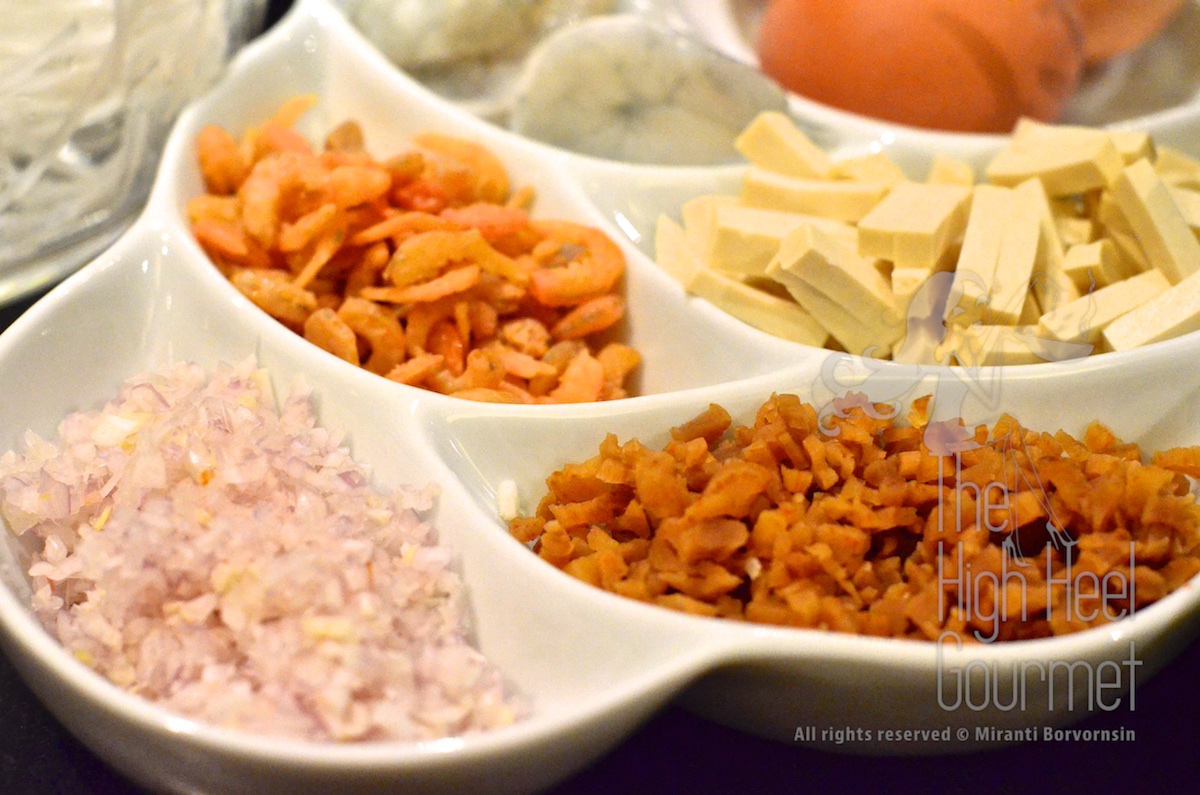
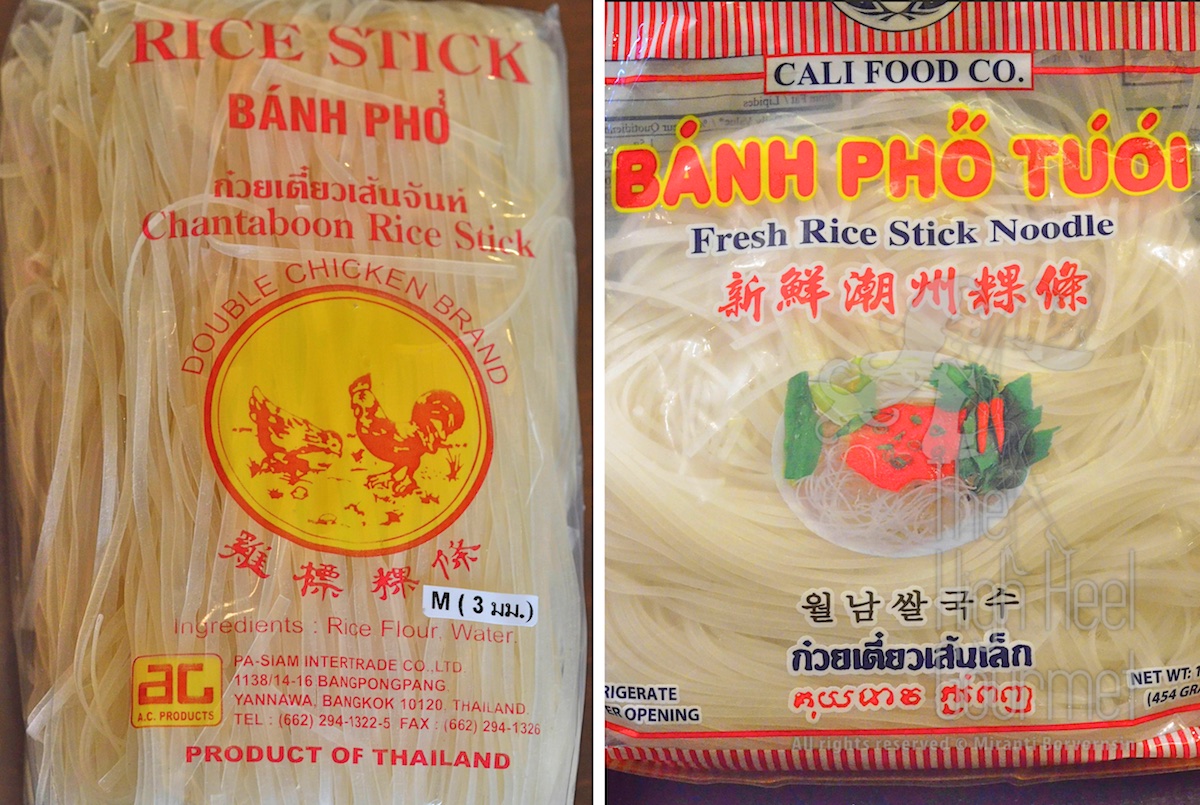
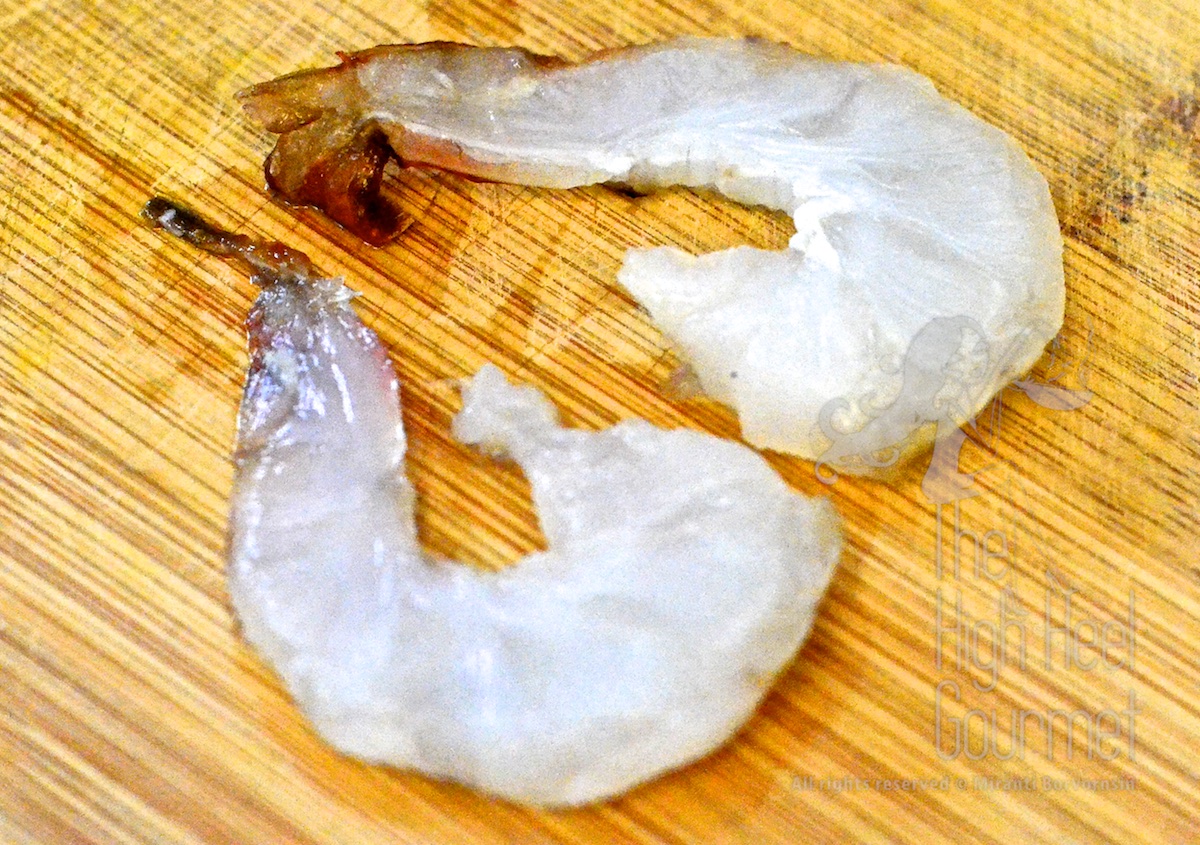
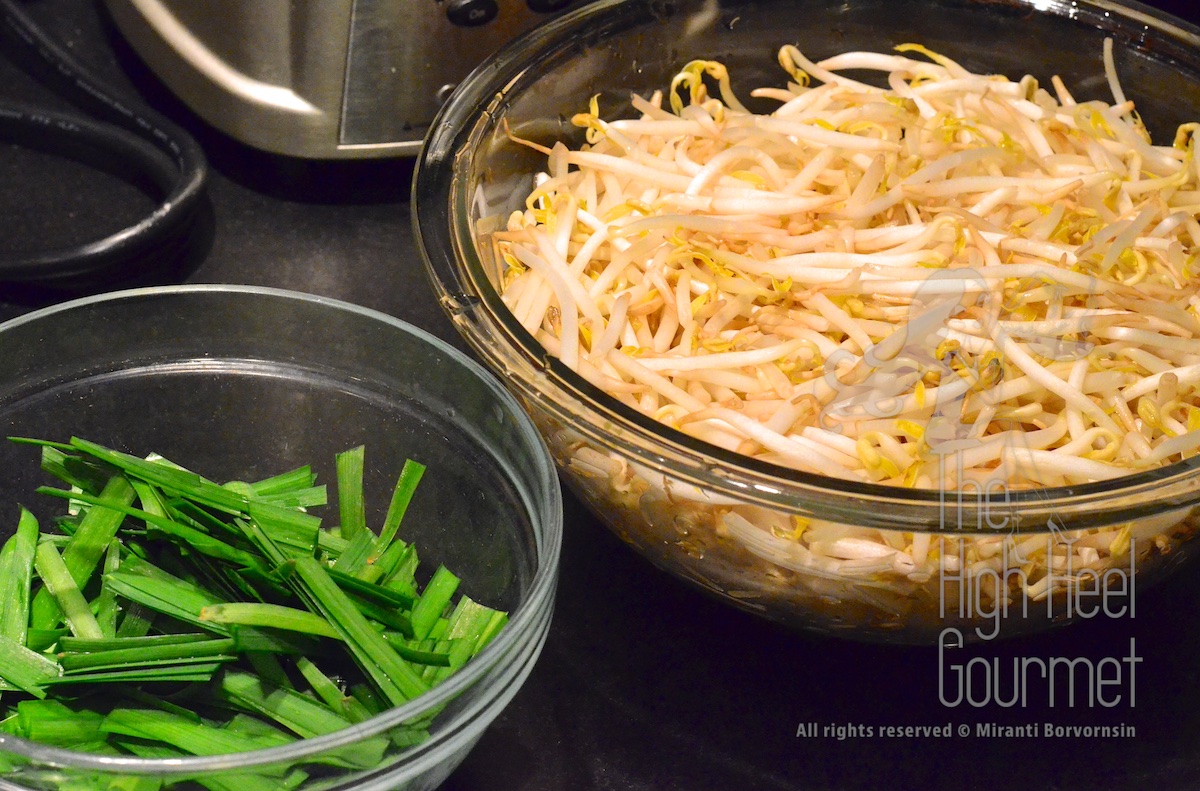
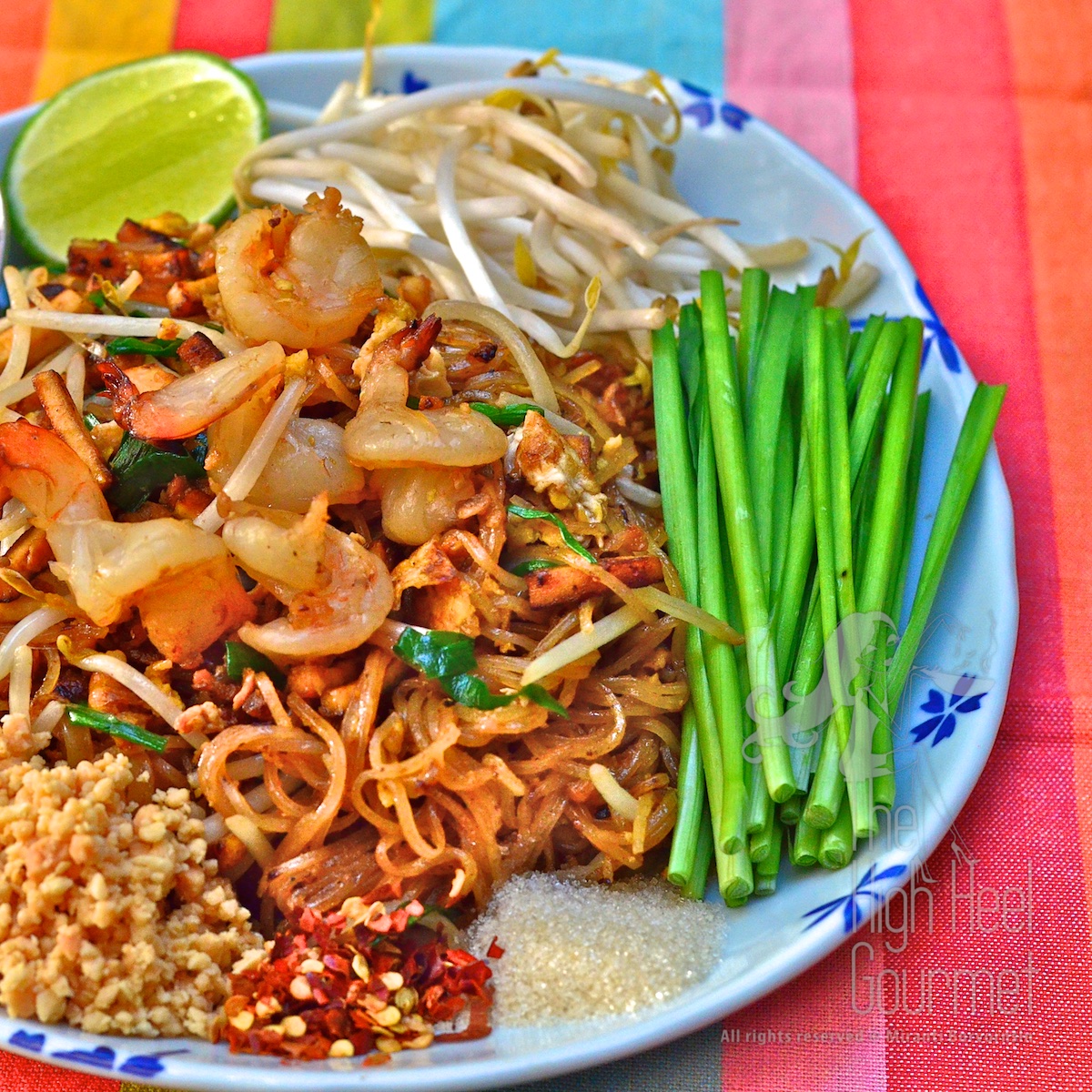
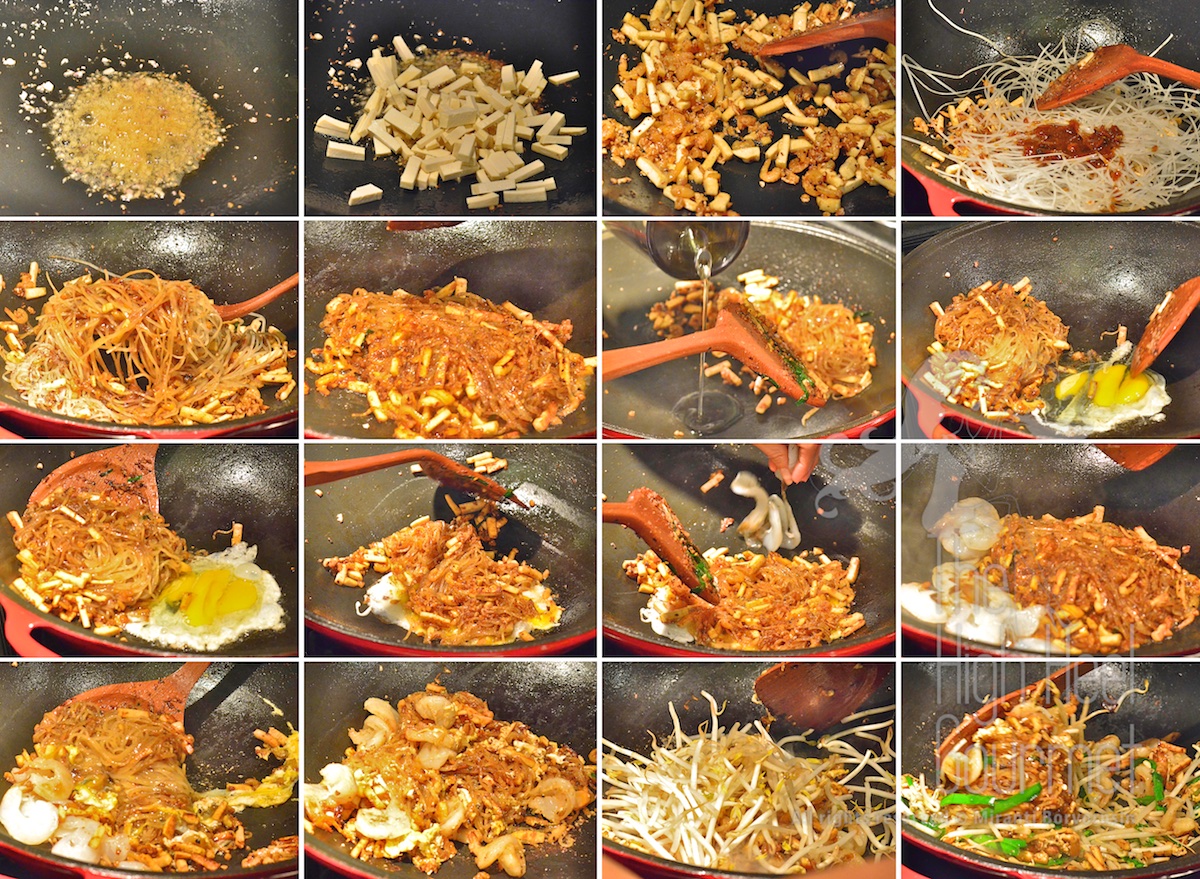
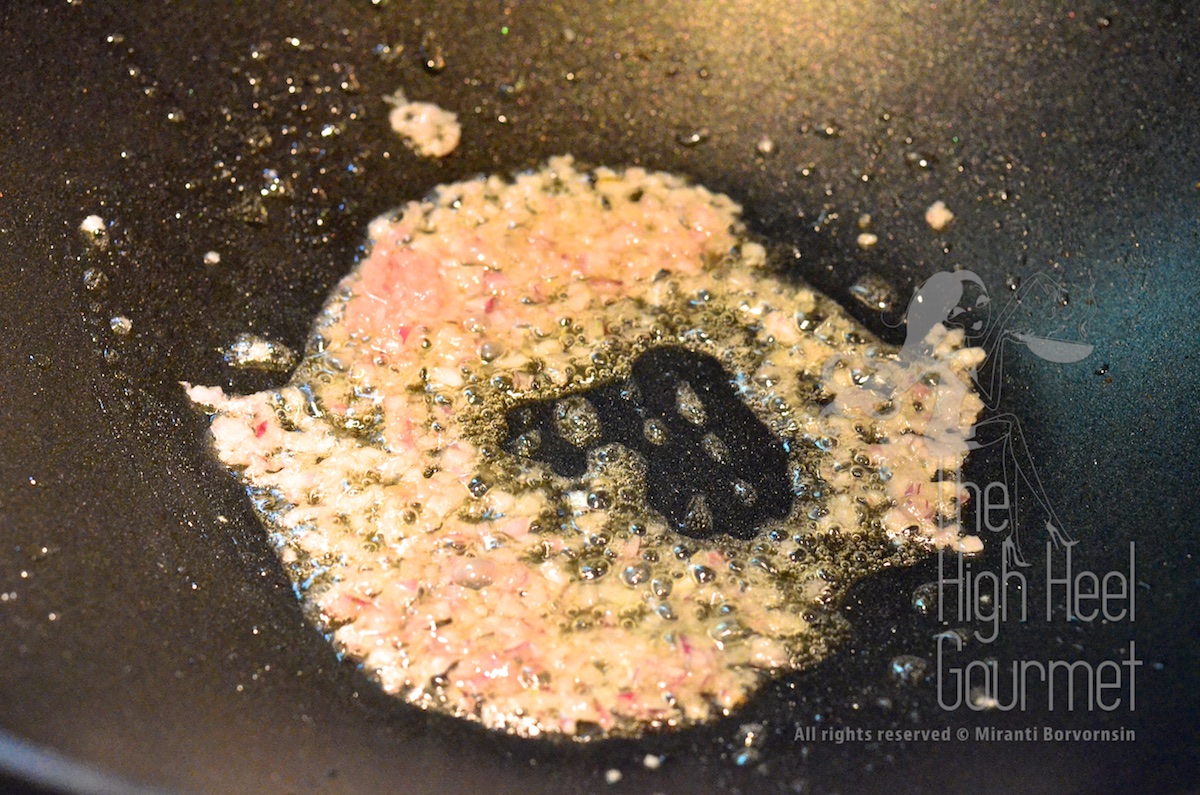
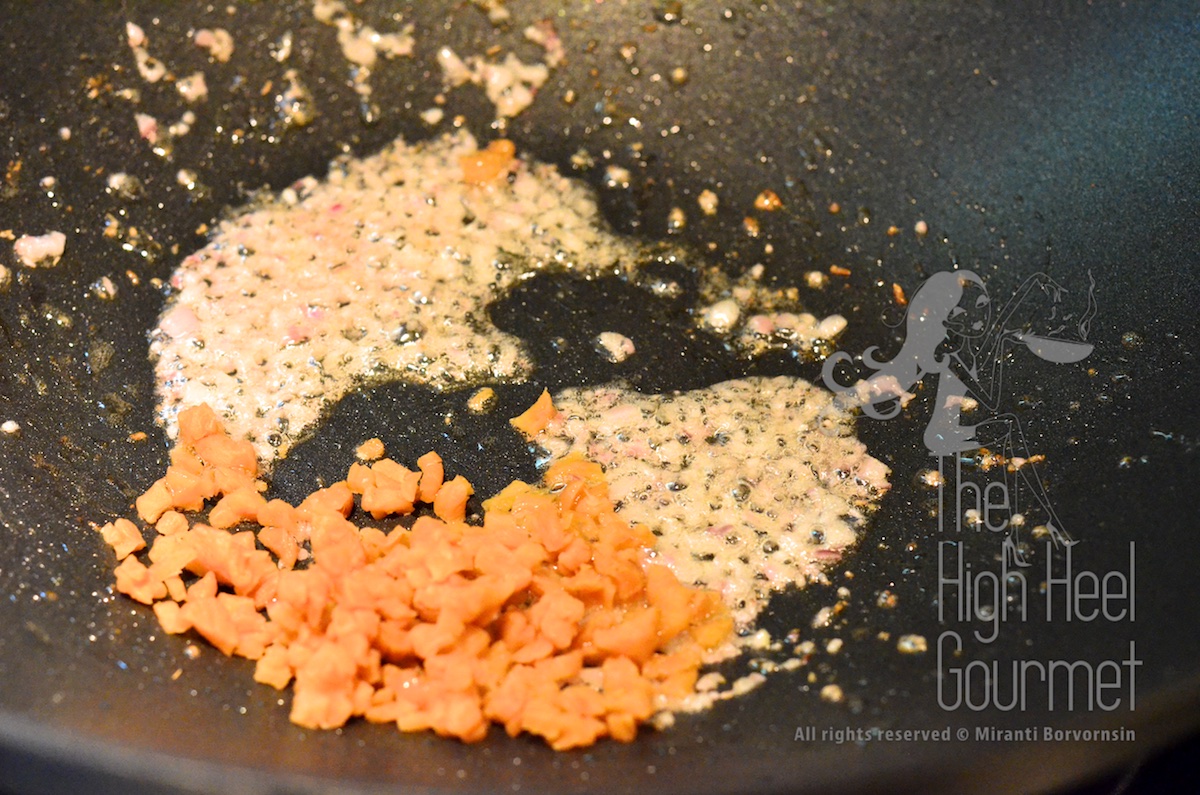
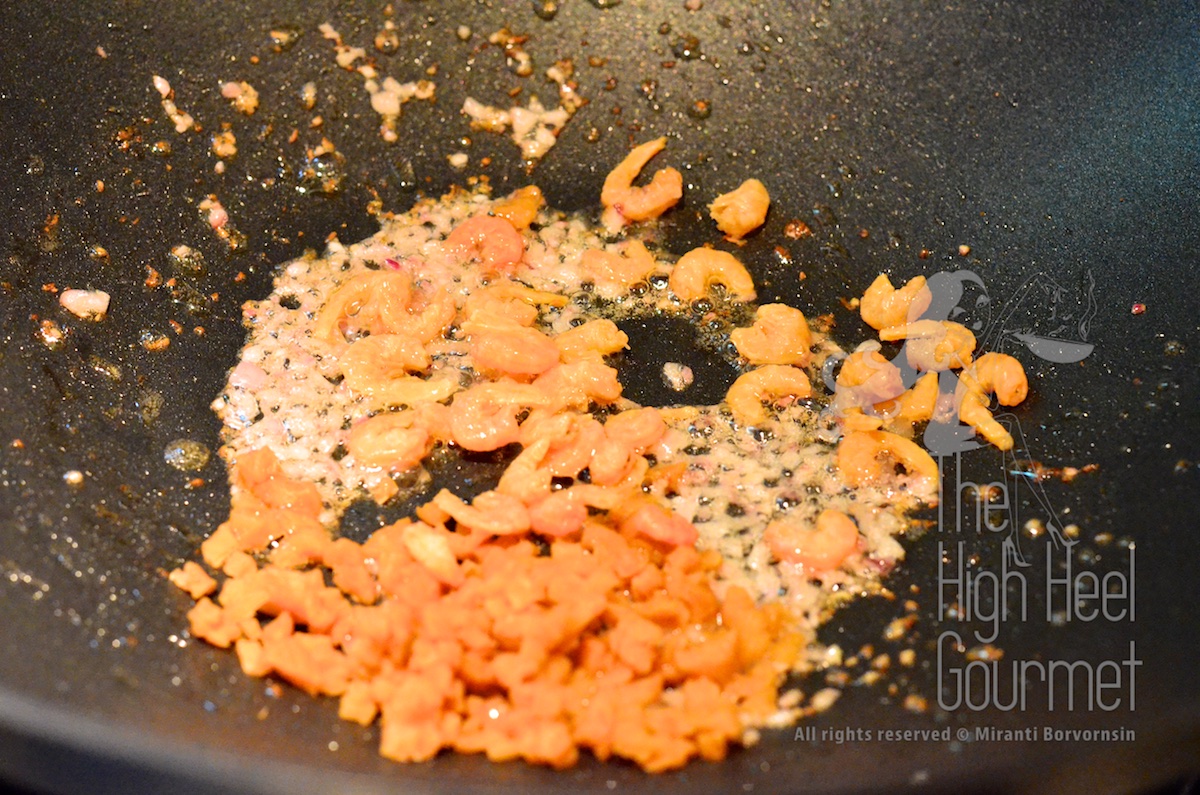
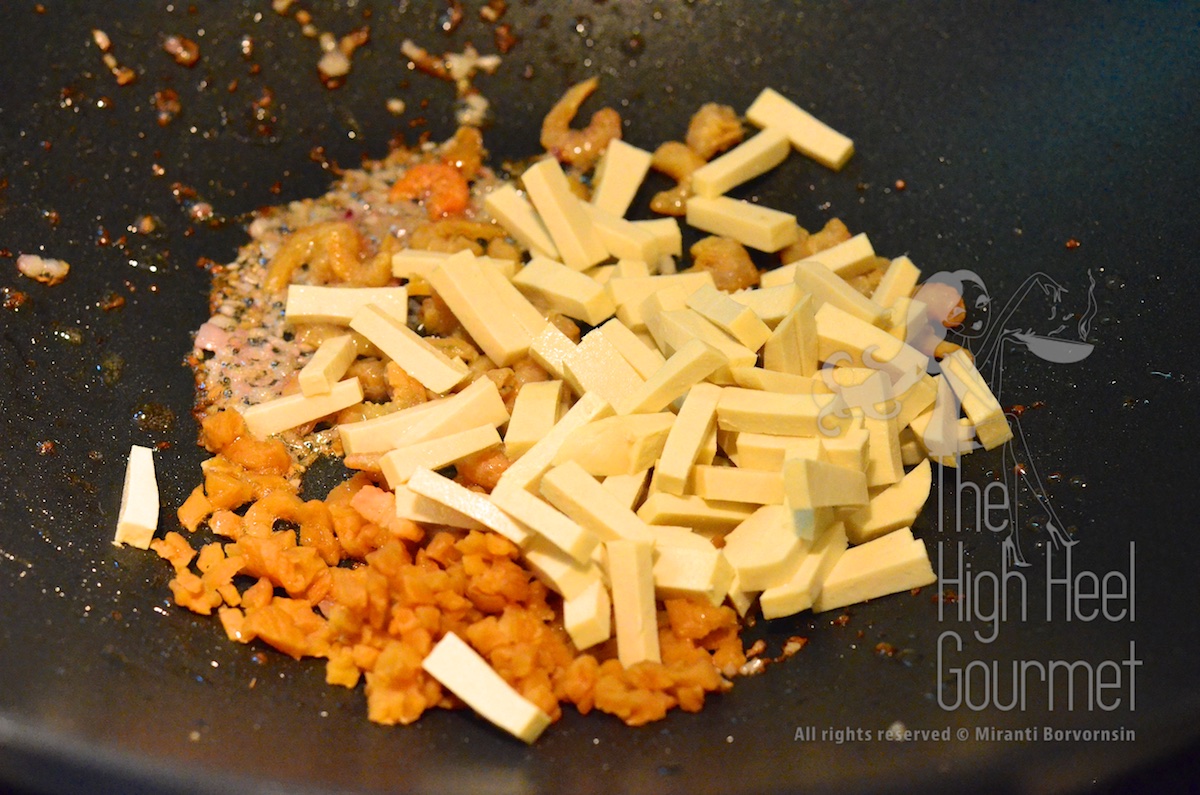
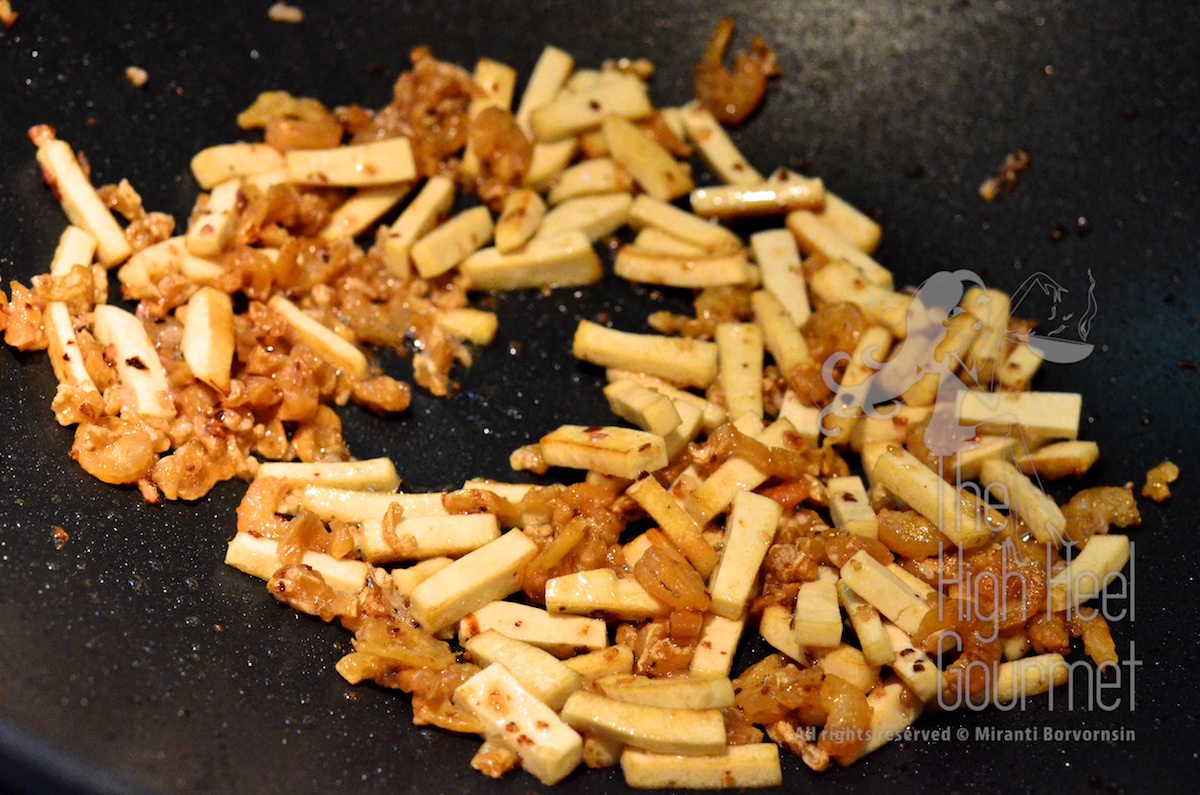
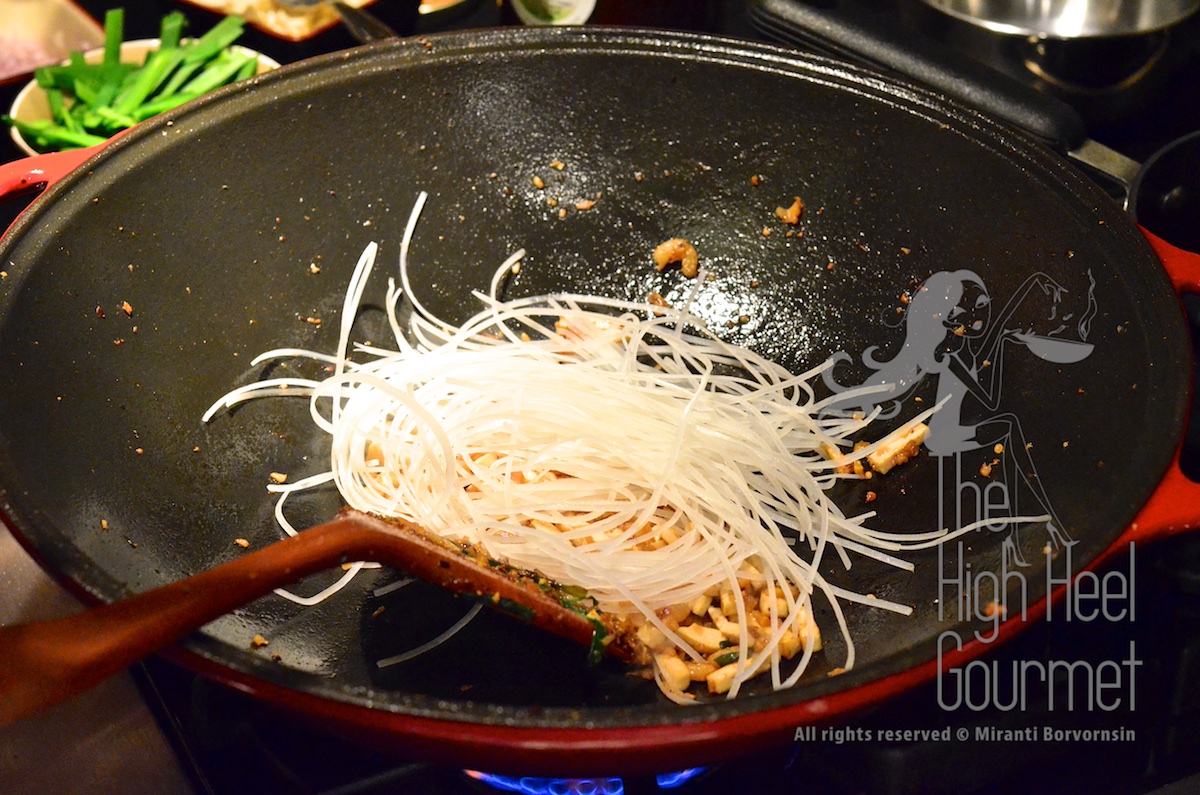
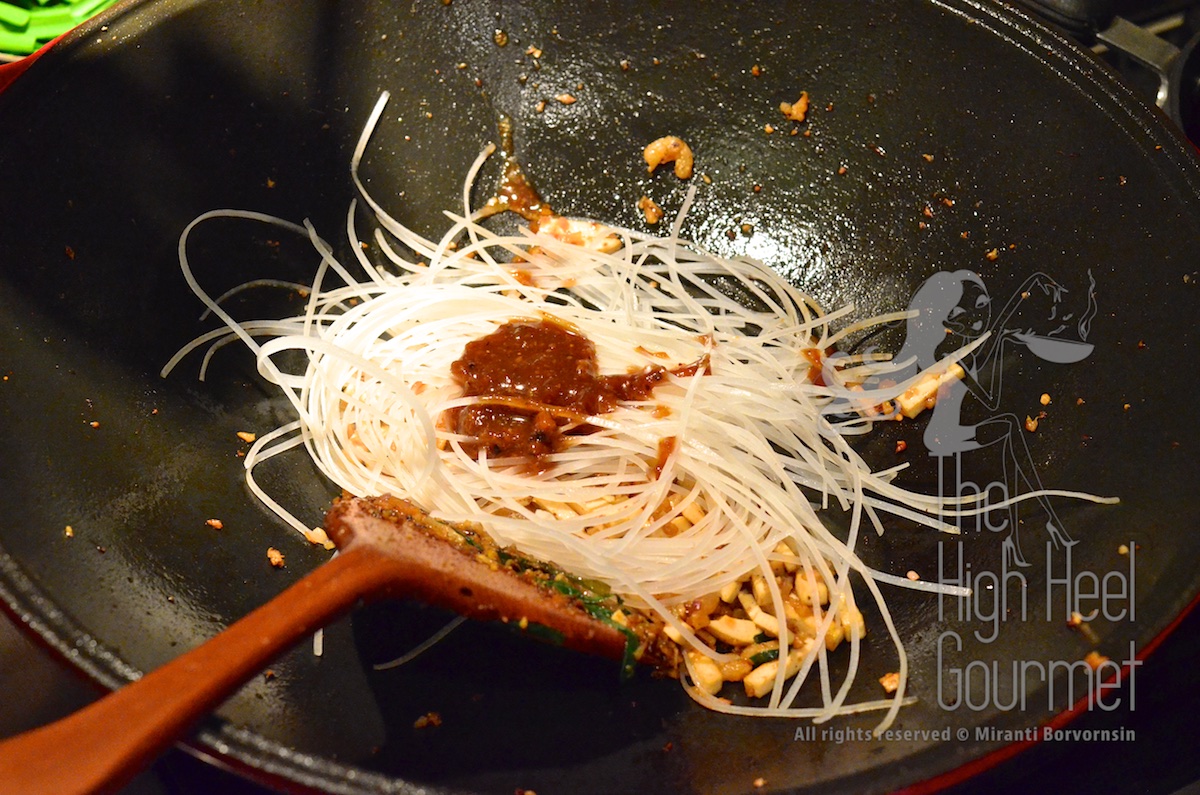
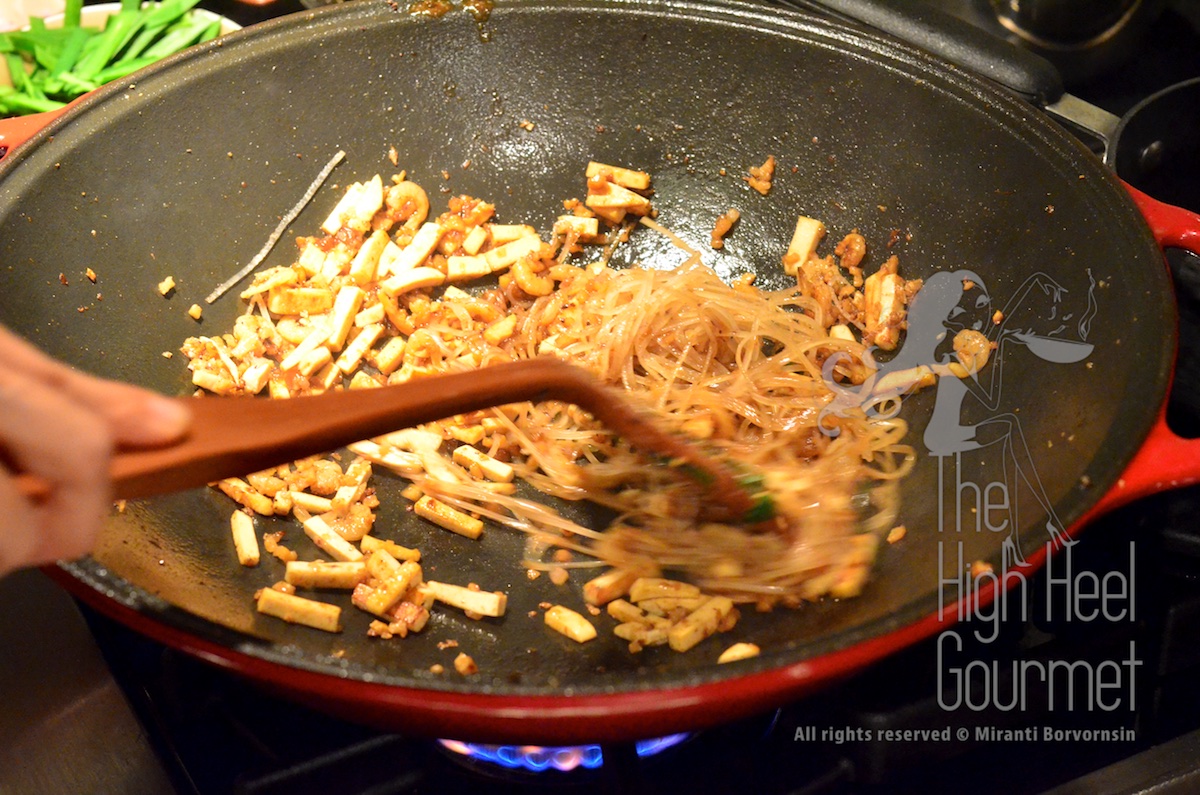
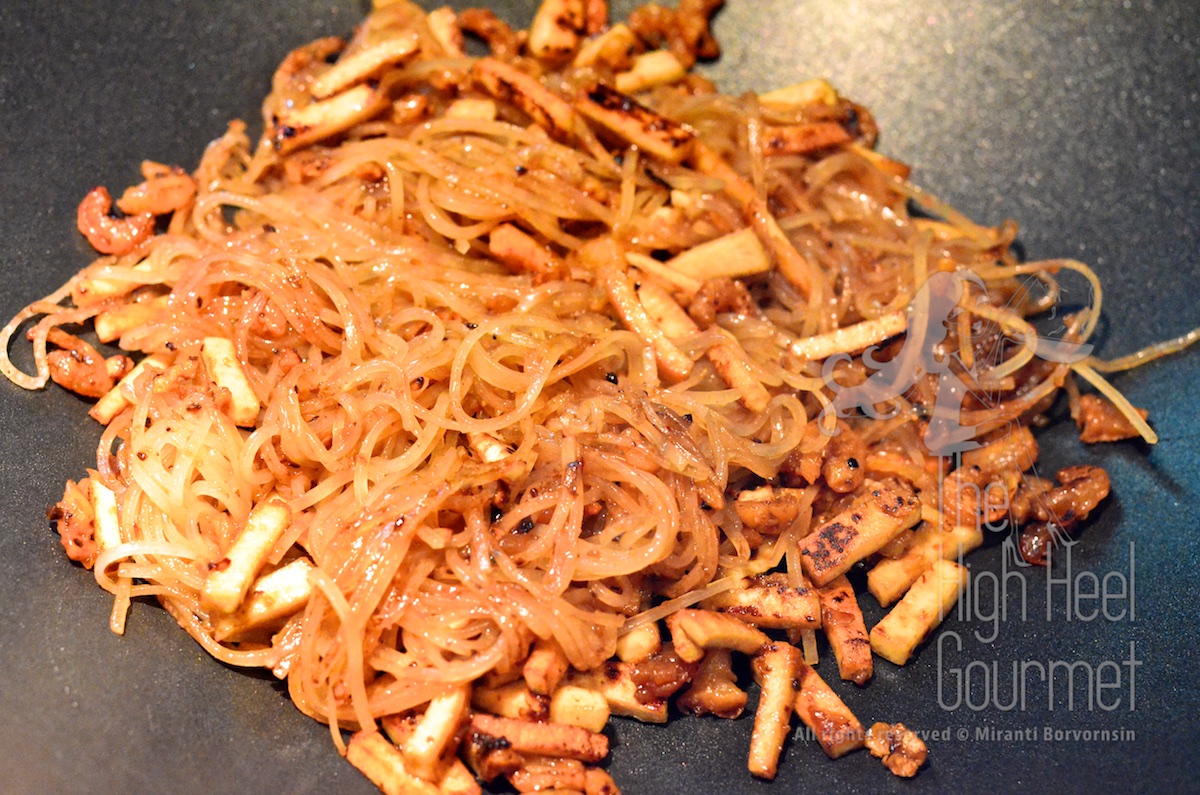
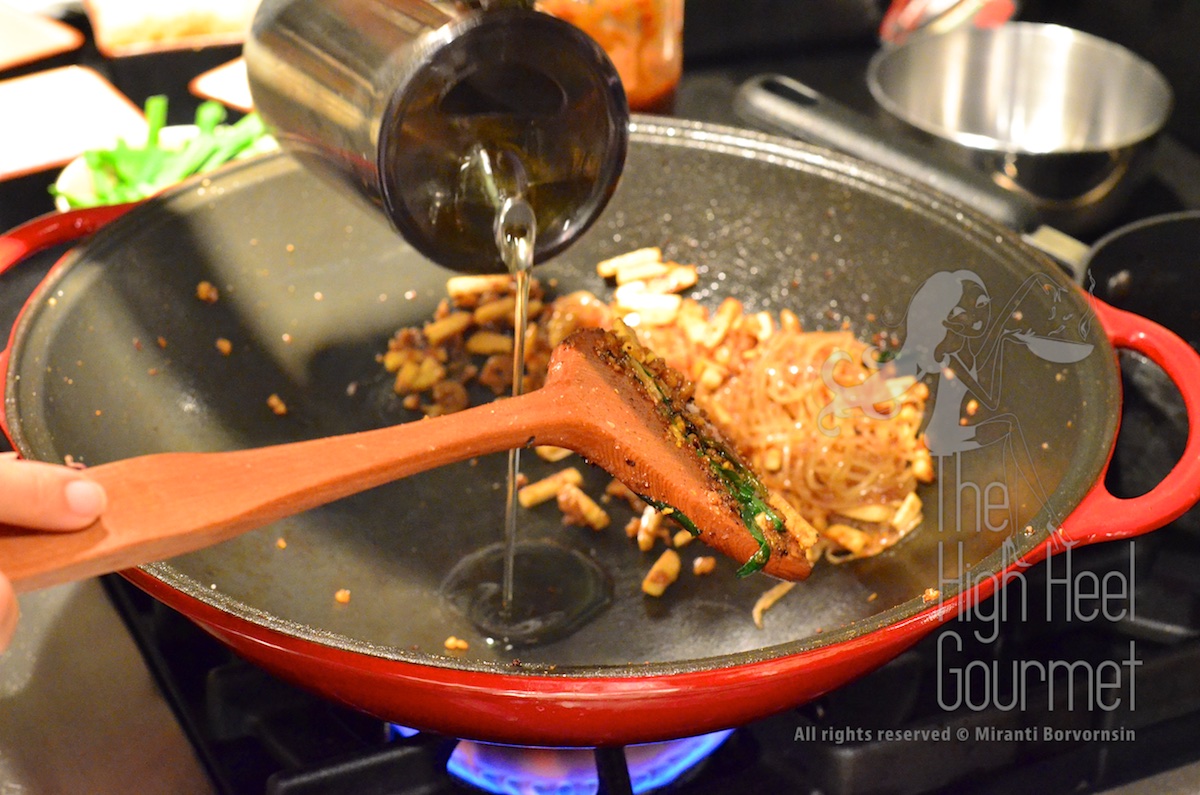
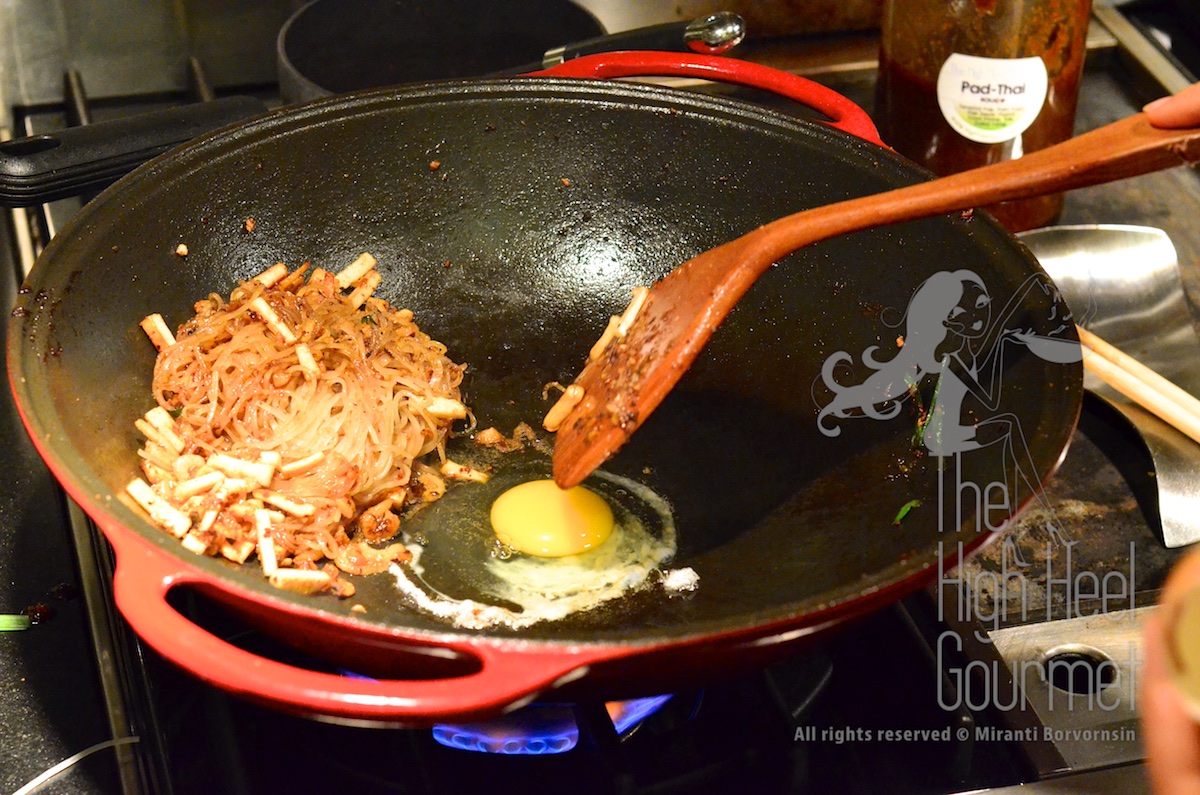
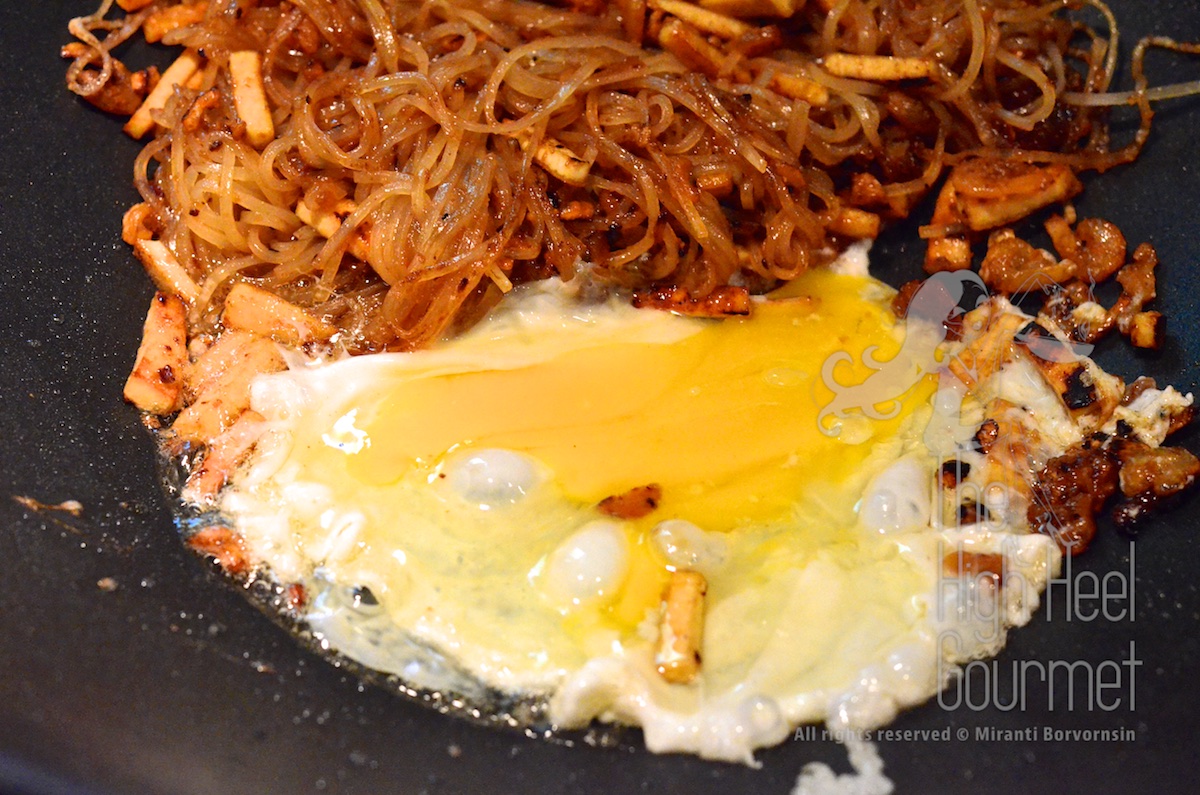
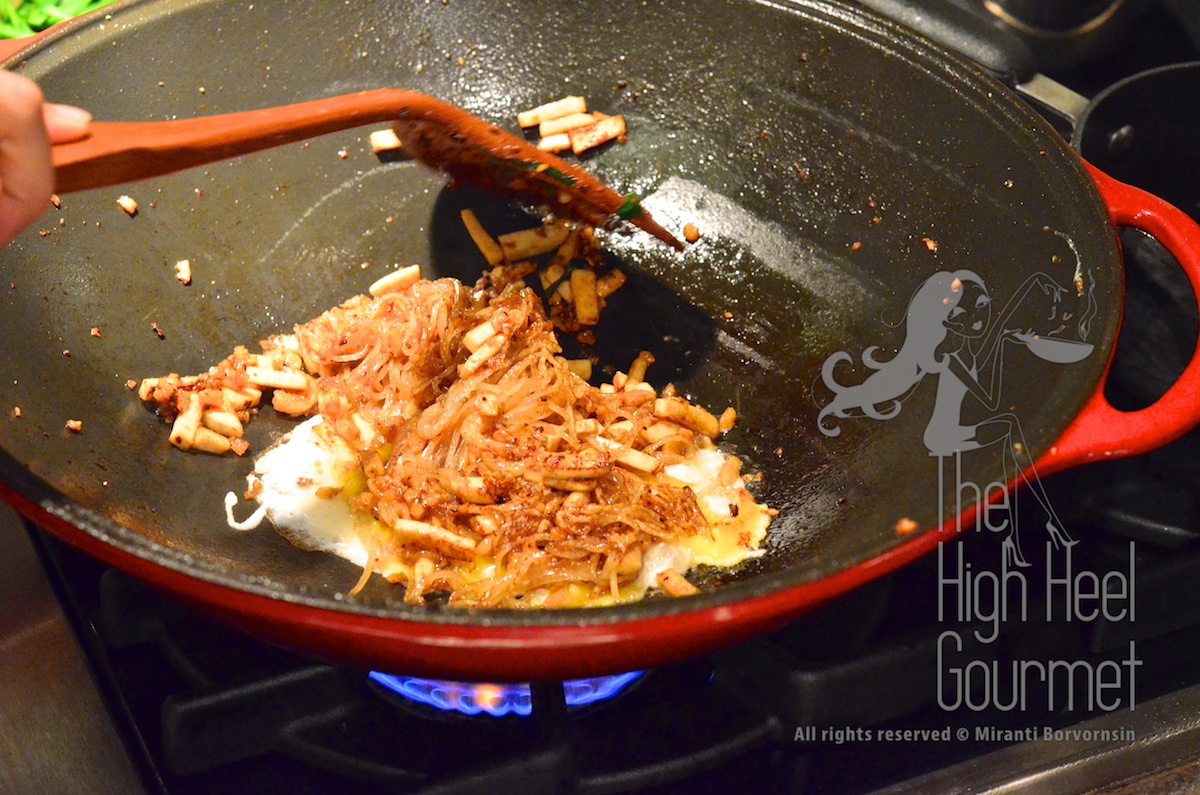
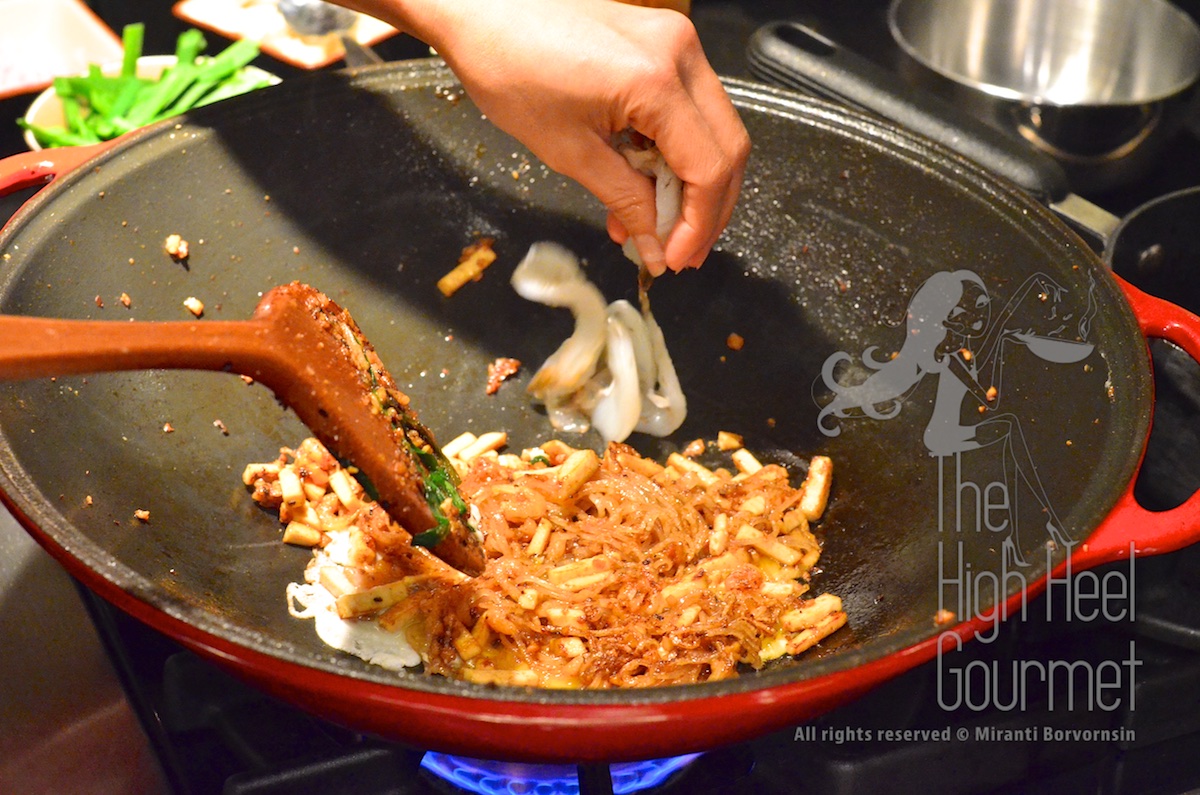
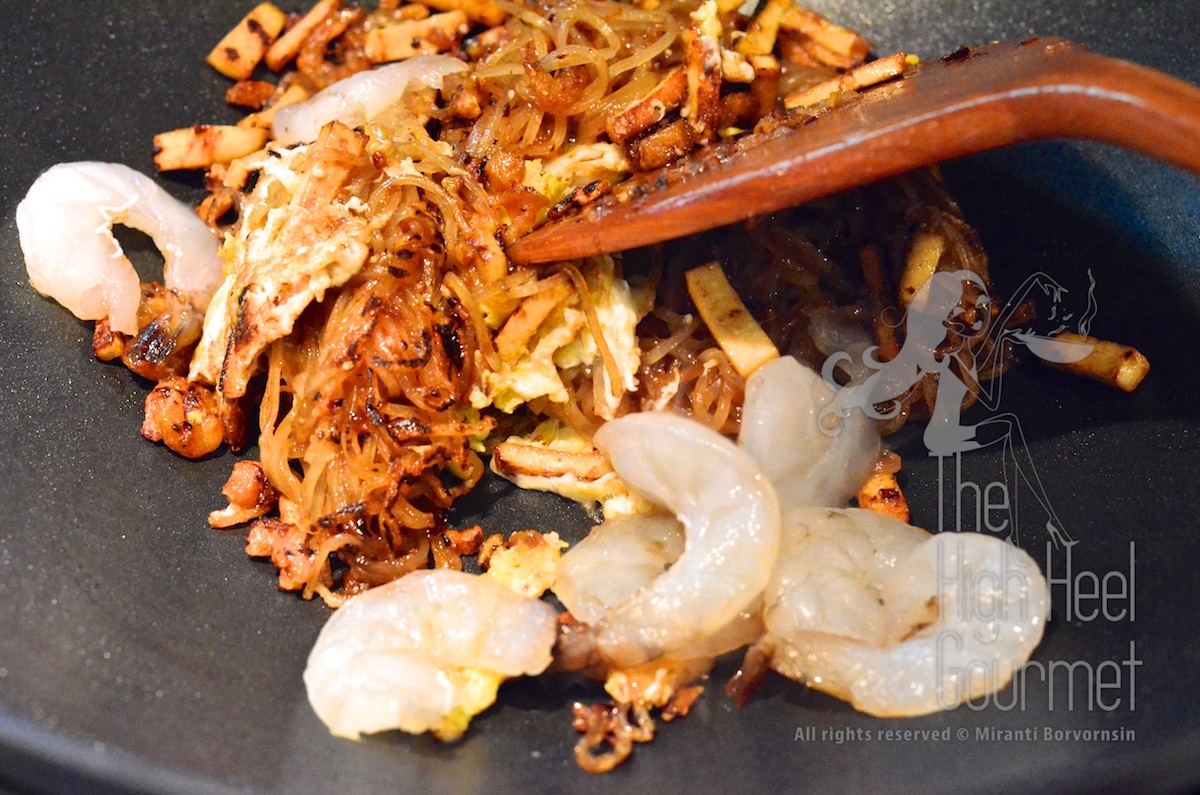

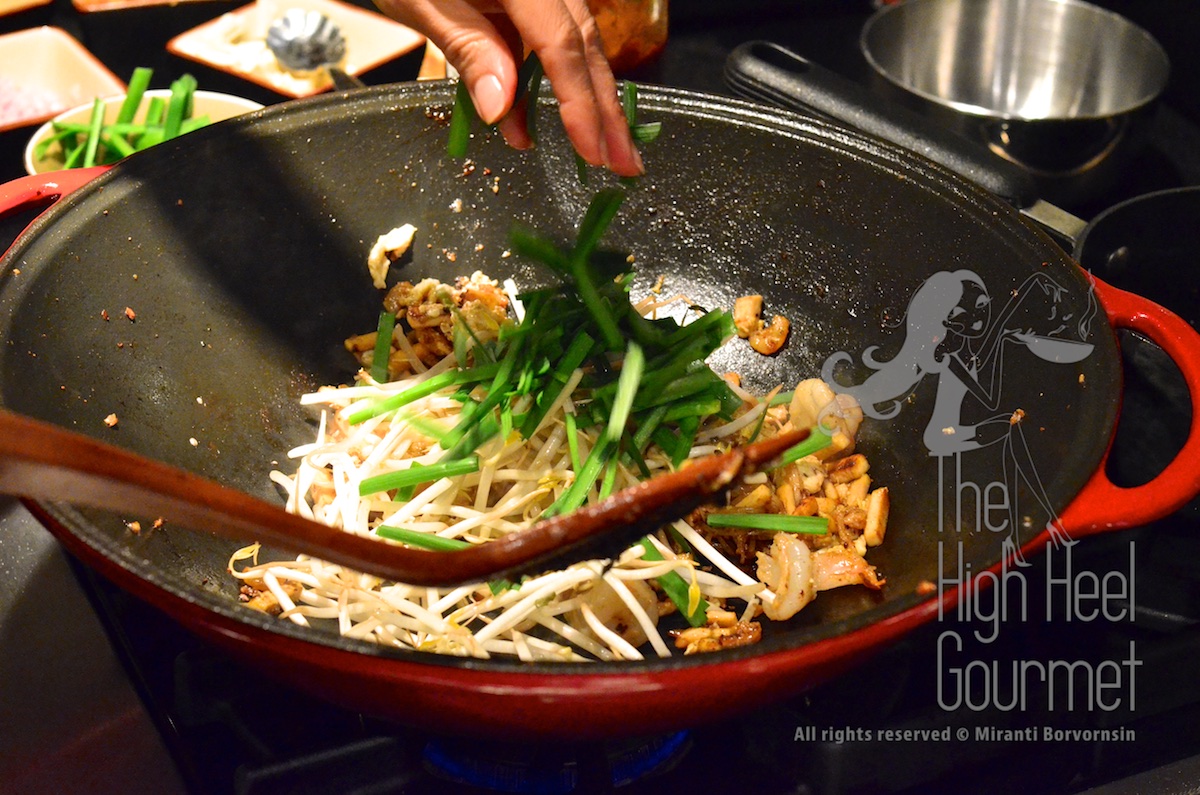
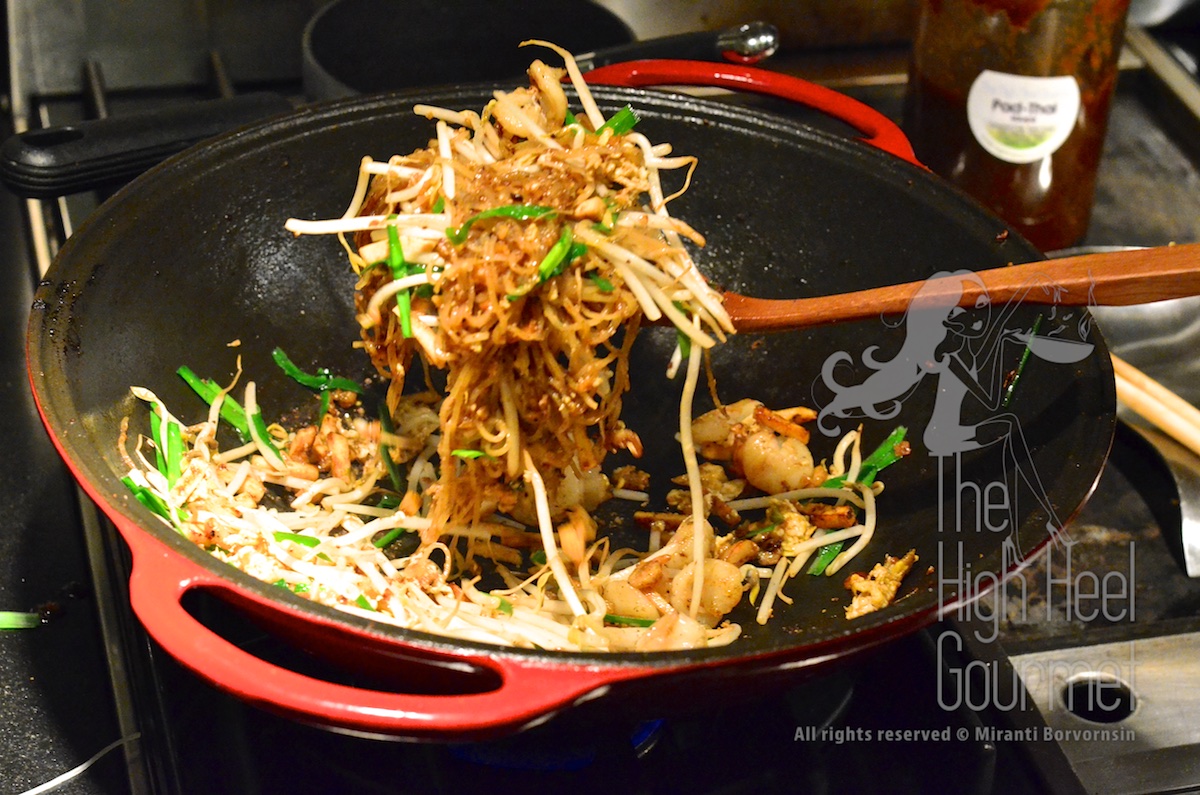
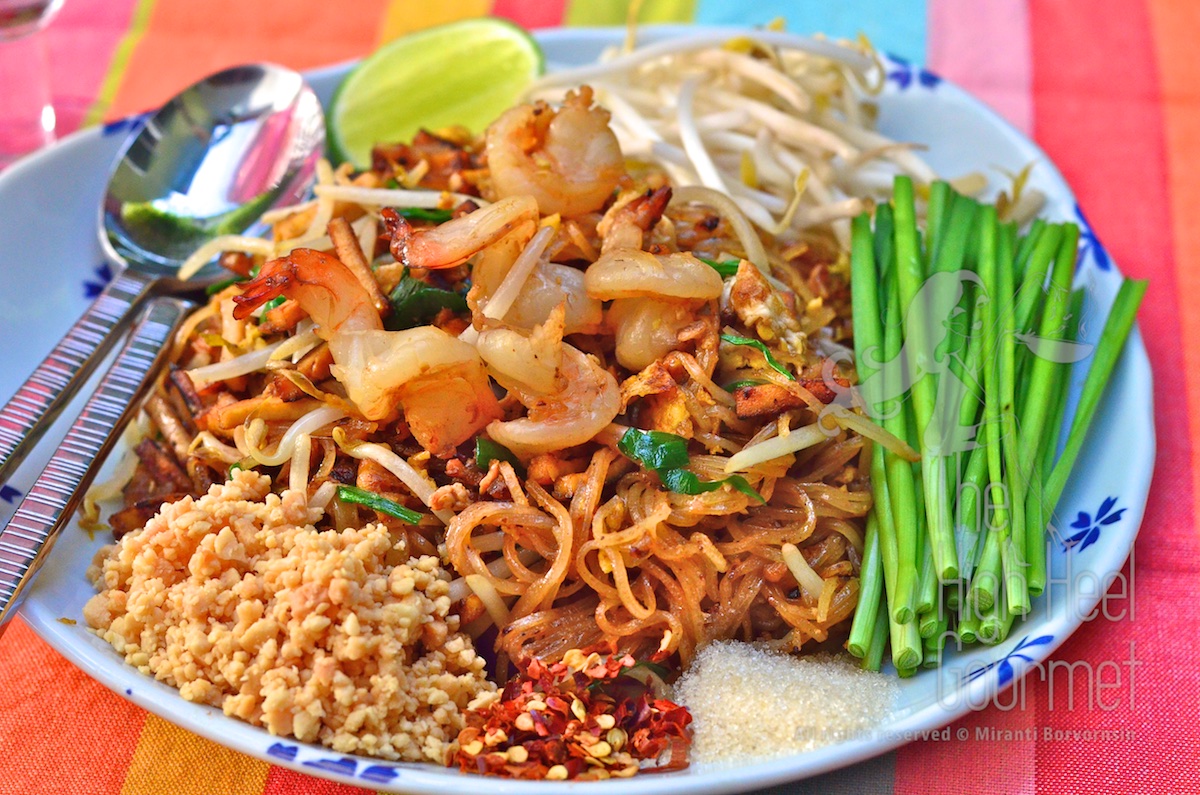

Wow everything looks so good!
Try to cook it 🙂 I’m sure you will be able to make it easily. BTW I like your new look so much more. I get to see the bigger pictures on a nicer background.
I will definitely give it a try. Thank you so much! That’s what I thought as well. My logic: bigger food pictures = better.
FINALLY!!!!!!!!!!!!!!!!!!!!!!! A Pad Thai recipe that looks great! do you know how many years I have wanted this! Thank You, Thank You, Thank You!!!
I’m glad 🙂 Let me know how it turns out.
Oh my god!! thank you so much for showing people what phad Thai really is. I was a chef in Thailand for several years and trying to explain to friends about this dish is such a headache…portions are the perfect size in Thailand…American versions look like a serving for ten! and no real traditional ingredients ever used…anyways..thank you and I look forward to future postings!
Thanks…I live in Los Angeles, the city that has the largest Thai community outside Thailand and also many Thai restaurants but I still have to make my own Pad Thai at home if I want it! and the portion they served here, you are right the whole tray enough for a family per serving…I’m glad you enjoy it. 🙂
I love pad thai! This looks fantastic!!
Thanks 🙂 BTW The Sushi Etiquette picture on your blog, do you know the real origin of it? I used it on one of my blog too and still don’t know who should I give the credit to?!?! http://www.highheelgourmet.com/2012/05/03/sushi-etiquette/
No, I have no idea! I originally saw it on FoodBeast but I doubt they are the originator. It’s all over Pinterest and Google if you type up sushi etiquette infographic.
I tried making pad thai once and it was a disaster! Will give this a try. Thanks for posting.
Let me know how it comes out.
I visited your blog. You have a lot of interesting curry dishes. I might try your lotus root curry sometime.
Yumm!
I’m going to give this a shot tonight.
Last night’s pad thai was far too salty, but I think that’s because I didn’t prepare the tamarind properly (way too much water) so it worked out to be a 1:1:3 sauce proportion, with the 3 being fish oil!
Wah.
🙁
Try the 1:1:1 and taste it to see if you like it first. Then adjust it to your taste. When I first made my own sauce I made the same mistake too! I couldn’t imagine putting that much sugar in my food, you know, but I adjusted it by add granulated sugar when I seasoned it before eating, just the way I saw it done back at home. Then I became brave…lol…increase amount of sugar little by little but it’s so difficult to give exact measuring because I never know how much water people or manufacturer put in tamarind paste, how dry the coconut palm sugar is and etc. So I always suggest taste it and adjust it to your preference…good luck tonight. Send me the picture if you wouldn’t mind showing 🙂 You can post it on “The High Heel Gourmet” page on Facebook!
This looks delicious, your photography is beautiful!
Thanks you! Your blog has a wonderful photos too. I usually cook in the evening and don’t have a lot of day light to photograph my foods. Envy at you 🙂
Wow, what a great post! Excellent pictures 🙂
Thanks 🙂
Your pictures are beautiful!! Such a nice addition to the text 🙂 Love Thai food!
Thanks Michelle! Well, after you are done with French cooking, may be you would try Thai cooking next 😉
BTW Have you ever heard about this cook book by Gala Dali, Salvador Dali’s wife, called “Les diners de Gala”? It’s such an elaborate cookbook illustrated by Salvador Dali himself. I’ve got this book and that will be a cookbook I would like to follow every recipe even though some recipe used very weird ingredients (You know not very often you would heard a Thai girl talking about “weird ingredients” since Thai cooking contained uncountable numbers of them already…lol).
This is really descriptive! Thanks for the post – will try it soon!
Thanks. Let me know how it turns out. You can post picture on my facebook page http://www.facebook.com/HighHeelGourmet
This is great! My husband and I spent some time in Thailand, and this definitely makes me hungry for pad thai.It’s great to find an authentic recipe. I’ve never been quite pleased with how mine has turned out in the past. Our favorite Thai dish that we still make is som tom (the papaya salad). Do you have a post on that one?
Wow…Sorry that I missed your comment for this long. Yes, this summer I will post a recipe for many different type of SomTam. Which one is your favorite? The one with green bean (long bean) and tomatoes and peanuts. Or the own with crab or cook shrimp in it.
I am eager to try your recipe — we love Pad Thai in our house!
My wife loves Pad Thai. Thanks for sharing your recipe.
Chef Randall
savorthefood.wordpress.com
This looks great! Will try it out one of these days
YES! This is a recipe I like to see! I will be following these steps soon I hope. Thanks for a great detailed post.
Thanks 🙂 Post the picture of your padthai on my facebook page so I can see it.
*drools*
I’ve made weak pad thais in the past… as most my culinary learning these days comes from eating out and tasting what is in a dish, then trying to replicate at home. This one dish i’ve struggled with. I missed the radish, i’ve garnished with Cilantro/Coriander and used fresh chilli in the frying. I absolutely need to try this, and i’ve currently got all the ingredients for it too!! *facepalm* ’bout time I do it properly.
Thank you very much for this recipe!
Great! I want to see it. Are you going to blog about it?
I might make at some point this coming week. I tend to forget to photograph things tho, I’m too focussed on cooking and then eating it!
Tell me about it! So many time I have to re-do whatever I’m blogging about just to get pictures…because the first time I made them I didn’t take them. My hands were dirty or I was busy eating them…lol…If you are going to blog about it I’m excited to see but if you are not, then post it on my facebook page so I can see.
Thank you for visiting my blog. I think your blog is fantastic. Would you be interested in guest blogging on each other’s blog?
Are you kidding me? I LOVE your blog. It’s fun, entertaining and you know how I love history more knowledge about food! Yes, I would love to exchange blogging.
Ahhh… so that explains why my noodles turned to a gummy mush! I cooked them like a pasta noodle instead of just soaking them. Fantastic detailed post!
Yes, for rice noodle cooking them one step is enough. Unless you want to make Pad Thai with wheat noodle, I recommend boiling them al-dente before stir-fried them.
Love this recipe. Pad Thai is one of my favorite foods.
🙂
Oh my gosh!!!! I’m not sure I’d ever do this much work but I wish you were here to cook at my house. I can almost taste it!!!! dru
lol…I’m so use to prepping them and in my mind this is just one dishes, so the ingredients can’t be too much, right. When I have to pack all the ingredients to go cook this somewhere else, then I realized “holy s***! They don’t all fit in two boxes”…
You have great recipes.Our daughter in law is Japanese (her dad’s side) and she is a good .cook.I gave her your recipe.Thank you for liking my post .Wishing you the best.jalal
Love your blog!!! Thanks for stopping by! I’ll definitely give a try to your pad thai!!!Zillion thanks for sharing it
🙂 Thanks
This is very impressive! I know I will never make pad thai myself because it’s so labor intensive and we have great Thai available here. I pinned this under “Gorgeous Dishes I Will Never Make.” 🙂
Ahhhh…really…it’s really not too complicated. I’m thinking I might just do a “PadThai pack” that put all the necessary ingredients together including the sauce and ship it off. Then you can do it without having to run around finding all the ingredients…How’s that sound?
Good instruction and clear photos. Sorry that I can not try the recipe as I am very allergic to sea food which includes fish and oyster sauces.
You can substitute the fish sauce with soy sauce, substitute the shrimp with chicken and also eliminate the dry shrimp completely, then you get to eat chicken pad-thai. 🙂 Well my secret when I make it for my friend who allergic to seafood, I use about half a teaspoon of Australian Vegemite per dish to add the umami taste that was missing by eliminate the dry shrimp. The result was superb!
Looks fantastic. I love Farang Pad Thai (sadly all I can get at local Thai restaurants) and have been looking for a genuinely authentic recipe. I have a local Asian market close by and can get fresh Thai herbs and vegetables shipped in. When I’ve tried out your recipe will report back.
Made twice now and way, way delicious! Substituted dry preserved cabbage for turnip as they were out of the turnip.
Only thing I need to perfect now is the rice noddles and any advice would be appreciated. Both times they stuck together and were kind of gloopy. I used 2.5 mm flat noodles.
First time I soaked in boing water for 5 mins drained (but did not wash) and then they went straight into the wok. When they went into the wok they were pretty much cooked already with a slight ‘bite’. Used 1 tablespoon of water to try and seperate them.
Second time I soaked in boiling water for 3 mins and rinsed thoroughly in cold water and then left to stand. Noodles were just crunchy in middle. Used 1 tablespoon of water when cooking to try and seperate.
Both times noodles were in wok approx 4-5 minutes befrore being served.
Do not use boiling or hot water to soak the noodles. Soak them in cold water until they are pliable, means soft enough but not cook. I never time it but I use cold water so the noodles never gets too soft. I assumed never more than ten minutes.
I have you bookmarked to check out new stuff on this post
Sorry missing this comment for a month…shame on me. Do you like Pad See Ew? I just posted the recipe.
I wanted to inform you for this great help!! I definitely enjoyed every little bit of it.
Cool!
Sounds great – this one I definitely need to try. Thanks for the post, and for stopping by and liking my blog .
Sorry missing your comment for a month! Did you have a chance to try the recipe yet?
Comprehensive and accurate. I have hunger now.
Thanks
A fascinating and detailed write up on a dish that’s always been a mystery to me. Definitely bookmarking this one. Thanks!
Your welcome 🙂
wow! Really complete instructions! My hubby had pad thai last week and said it wasn’t as good as he would have liked. I’m going to show him this.
Also, loved your reference to Frank Gilbreth. I grew up in a big family and Cheaper by the Dozen and Belles on their Toes are in my all time favorite books!
Sorry for late reply…sometime I was so busy with the taxes until now. I LOVE the fact that you know about Frank Gilbreth. I think less and less American people know about him sadly. Both books still my favorite even though I grew up with only one more sibling but my dad grew up with 10 +himself so my grandmother has 11 kids…OMG…I didn’t know how did she manage. This is during the WWII too! So my dad loved the books and so do I. I read it in Thai translated version and then English.
The first time I ever had pad Thai was on a hotel rooftop in Chiangmai. I know that was the real thing. Thanks for teaching me how to relive that great memory.
Cool!
Ooh – I’ve been looking for a good Pad Thai recipe – excited to try this one.
Yay!…Let me know how it turn out. Post your padthai picture on my Facebook page! I want to see it. 🙂
This looks amazing! I am a HUGE pad thai fan and have made it at home (not the authentic way like this!) I will have to try this. Thanks!
Did you try it yet! Post the result on my facebook page so I can see it too 🙂
This is a great blog. Not only does this recipe look delicious, but your photos are fabulous! I am in awe. 🙂
Thank you…You are so kind!
I won’t even attempt to do this, because I’d never get it right. But I enjoyed reading this. Pad Thai is one of my favorite dishes, the Farang pad thai because i am in the US, but I don’t like the versions with all that chicken and beef added, it just isn’t right somehow!
Awwwww really…so the Pad Thai will not get a personal poem from you!?!? Noooooo (sobbing)…please, pretty please! I can send you a sauce, how’s that? It’s easier once you have the sauce.
Reblogged this on ELANA – The Voice of the Future.
Thanks Elana!
I tried to make pad thai once and it was a royal disaster. Been scared ever since of trying. May have to try your recipe
I think my recipe is quite foolproof by now…try it! Post the result on my Facebook http://www.facebook.com/highheelgourmet if you have any question you can ask me.
Can’t wait to try this!
🙂 Post your result on my facebook page if you like.
Looking forward to trying this sometime! I appreciate all the very detailed directions! It looks delicious!!!
You are very welcome 🙂
I absolutely LOVE Pad Thai and make it myself. Will definitely try your recipe, it looks super yummy! Thanks for visiting!
Thanks for visiting me back…I want to try your bake Zeppole recipe soon. Looks yummy. I never know that I can bake this thing. Much less complicate than deep fried.
Sounds really tasty
Thanks
hey thank you for all the likes – gotta say, we love Thai food so much …it’s a let’s go out for … treat !
🙂 It might be…let’s stay in for treat in the future!
Hello Miranti! Although I am part Chinese, I equally love my father’s home cooking and Thai food! I am so excited to have found you and your wonderful blog! Thank you for liking my smoothie post 🙂 Blessings!
Thanks for a nice compliment. I am a half Chinese myself but half by taking quarter from my dad and another quarter from my mom because they’re both half Chinese.
I’m in to smoothie these days for health. Even though I don’t have anything interesting to post about smoothie yet. May be smoothie sorbet in the future, I don’t know…thanks for visiting 🙂
What a fantastic post – love the detailed info and heaps of pics!
🙂
Thanks for the visit
Thanks for visiting me back 🙂
Will have to try this ! Yum !!
Great! 🙂
God, this looks so yummy! I posted it to my Pinterest so I remember to try this when I have a free afternoon. Luckily, we have the massive Uwajimaya market in Seattle, so I’m pretty sure they have every ingredient needed. 🙂
Thanks…I love that in Seattle even regular market have a lot of Asian stuff too. My friend took me to a market there that has fresh seafoods in the tank and fresh foods almost like Wholefoods but it’s not. Wonderful city to live in (minus the rain of course).
Not sure what you’ll think of this, but was taught how to make Pad Thai by an elderly woman herre in Thailand and her secret sauce consisted of bottled chili sauce and ketchup! She added fish sauce separately. I was shocked to see what I would call ‘cheating’ ingredients, but was one of the best Pad Thai’s I’ve had while here!
ps thanks for stopping by my blog.
Yike! You know I have padthai recipe on my blog, if you are interested to make. Have you gone to TipSaMai in Bangkok for PadThai? I wouldn’t thing anything with ketchup would be bad but to call it a padthai is stretching wayyyyy too far.
I thought the ketchup was suspect, but it did taste good! Probably because my western taste buds haven’t fully evolved yet. Haven’t been to Bangkok yet, but will look up it up when we’re there. Thanks for the tip. And will check out your recipes once we have our own kitchen again.
Enjoy traveling there! I’m envy.
I went to read further on your blog and found out why your PadThai has ketchup. They just want to please you 🙂 because that the “farang” ingredient in their minds so they added it to the stir fried noodles they made for you.
G’day! love the step by step photos and also in reading what is considered “authentic” and not!
Cheers!
Joanne
What’s On The List?
http://www.whatsonthelist.net
Looks delicious and truly authentic. Thanks!
🙂
This has me drooling for Pad Thai!
🙂 make it, make it.
How i wish you live in Lagos, Nigeria. You sure have a way with food. Thumbs up my friend 🙂
thank you for visiting my blog. I love Thai food and ate it for lunch almost every day on my holiday just because i could. My wife loves Pad Thai and invariably she is disappointed as happened just last week, I think it is so nice of you to put so much detail, and photos, and little details that come from experience into this post. I cooked two meals this weekend, both curry chicken dishes that everyone liked, but I would like to learn Thai cooking. Wonderful blog and I love your smiling picture you use for your blog, I sense you are a fun cook and enjoy sharing so others can enjoy good home cooking.
This is so wonderful. Shame on me didn’t see it for this long. I’m so busy in summer time with my failed (again and again too) garden and doing a lot of preserves form someone else fruits 🙁 I posted recipe for jams so people can get busy too.
I hope you are successfully making PadThai for your wife now. That’s so nice of you to do that. I won’t let my husband cook that much even though he’s an awesome cook. He definitely make better American omelette than myself but we don’t eat that very often.
Oh my gosh, this sounds delicious! Thanks for liking my blog. I’ll be following yours!
Fantastic informative post. I’ll try your Pad Thai next time! I wish I’d seen this before I started experimenting, though I do feel as I am on the right track. Thanks a million! 😀
How did it come out? Did you have a chance to try yet?
It was brilliant thanks. We made it on the campfire last week, and applying your advice the result was fabulous. I had to share the recipe around!
Cool 🙂 Wow…you make PadThai while going on a camping trip! That’s so way cool! I bet your campsite neighbors probably envy.
this does look authentic! i need to try it!
If you go to Thailand, this is how the PadThai would look like. 🙂
Thanks for the likes … I will admit …. I love eating Thai food out !!!
Wow! This looks like an amazing recipe and I will be trying it soon. Thanks for the mushroom soy sauce recommendation. I’ve never heard of it but will be finding and buying soon.
Did you find it? Try the site “Temple of Thai” or Amazon. They sure have to have it.
Liked this blog so much I’ve added you to my Great Recipes Websites blogroll with Hari Qhuang (Hari’s Got Tales) 🙂
Check down the left column beside the posts 🙂
Thank you 🙂
Came across your blog while looking at Pad Thai recipes. 🙂
Did you try to make it?
Not yet but I shall.
We won’t be trying this in the Beleaguered Kitchen anytime soon. But I love looking at all the pictures and fantasizing about this kind of cooking once the kids are in college…Thanks for visiting me at amomnextdoor.wordpress.com!
May be just the kindergarten, I hope…lol…Once they can give themselves a bath and do their own home work, you will have a lot more time, I’m sure. May be you even explore the real “hobby” too. 🙂 I like your writing.
Just reading this got my stomach growling. I know what I’ll be making for dinner tomorrow
this looks so Great!! I looove pad thai!
Thanks for visiting my site. I live Pad Thai and then will try your recipe video very soon!
Can you buy ready made Pad Thai sauce? If so what brand would you recommend and where can i buy it. Thanks
Yes, you can but I never use them. I came I several packages shape, bottle, jars, sealed in a bag and etc. In the pre-made PadThai sauce might contained shallots, tofu, dried shrimp and pickled turnip in the sauce too. So be very careful with the expiration date and manufacturer date. I don’t use them due to that and amount of preservative it’s contained.
As of brand, I’m sorry I never use them so I’m reluctant to tell you since I never experience them by myself but check Amazon and Templeofthai.com you should be able to find them.
Thank you for stopping at my blog! I look forward to read yours as well 🙂
I think everyone is loving this recipe– me too! thanks.
You’re very welcome 🙂
Yum!!!!!
🙂
I love this!
Me too 🙂
I made this for dinner tonight–the shrimp version for my husband and vegetarian for me. DELICIOUS!!! I can hardly believe I made something that tastes this authentic!!! Thank you so much for the recipe and detailed instructions!
Yay!…I’m glad 🙂
Hi Miranti! I’ve found all the ingredients and am going to try making pad thai for the first time.
Thanks for another great post.
I am wondering: is anything done in Thailand with shrimp shells and heads after peeling the jumbo shrimp for using in the pad thai?
In Italian cooking, I’d use them to make a shrimp stock that has lots of flavor.
They don’t use them to make stock since we’re not big on making stock. They usually eat the fat part (orange) in the head.
I love your blog and posts. This was so informative! I am a vegetarian so tried making a vegetarian version of pad thai today. I’m sure it’s not as good as what you have created here, but it was still delicious. Thanks for all your explanations, pictures and energy. X L
Reblogged this on My Life Uncensored.
Just made this. It’s very tasty but I’m not sure I got everything right. Is Japanese pickled daikon close enough?
I never use that one. Can you show me the picture?
If you are not sure these are links to the pickled turnip I used. In Amazon you have to search with the word “salted radish”
http://www.amazon.com/Superior-Quality-PRESERVED-SALTED-RADISH/dp/B00HU8W7SS/ref=sr_1_2?ie=UTF8&qid=1405732622&sr=8-2&keywords=salted+radish
http://www.amazon.com/Double-Golden-Fish-Preserved-Minced/dp/B00F5HWFUQ/ref=sr_1_3?ie=UTF8&qid=1405732622&sr=8-3&keywords=salted+radish
http://www.amazon.com/Importfood-Salted-Radish-14-oz/dp/B000F59ABK/ref=sr_1_1?ie=UTF8&qid=1405732622&sr=8-1&keywords=salted+radish
Sounds like there’s a slight difference.
Here’s what I have: http://en.m.wikipedia.org/wiki/Takuan
I’ll look for the kinds you use at 99 Ranch next time I’m there but I’m still curious if the difference is significant. The takuan is easier to find as we have Japanese markets as well.
Melody
Now I know exactly which one. Yes, you can use that. I used it before. Thanks for giving me information about it including the name. I always has it in my fridge but never know the name.
There are some differences though.
1) The flavor, Takuan has combu, dried persimmon peel and rice barn. Those would made the flavor slightly different than “Chai-po”.
2) Taste, Takuan tend to be more sour when Chai-po is the straight forward salty or sweet and salty, no sourness.
3) Color, the yellow is so extreme in some of the Takuan.
4) Chai-po in general is drier than Takuan.
5) Takuan was made by the Japanese, you know how squeakily clean they are, right? Chai-Po made by the Thai or the Chinese so they has the smell of the tropic sun since they’re drying them in the sun together with a ton of unknown dusk too! Those added flavors! (I hope you know that I’m BSing…haha…let’s scratch this one then)
The flavor would be slightly different but not to the point that I have to kill it. If you can’t get Chai-po then use Takuan is much better than eliminate it.
Do you have a printer friendly version?
Sorry Misty…I don’t have that. I want to put step by step pictures (in the later recipes) and I can’t do that with the printer friendly plug in 🙁
http://youtu.be/MA9Af2M_i-4
This is very interesting, You’re a very skilled blogger.
I have joined your feed and look forward
to seeking more of your wonderful post. Also, I’ve shared your
site in my social networks!
Hi, I am very impressed with your recipe with how to and not to. I am serious home cook and visit BKK on business and private as well as ahaan Thai restaurants in Tokyo, and always wanted to make authentic ones. Now, your recipe brought me right there! I was not too far away, but not about the sauce mix, which lead the sen lek to stick like a ball.
Anyway, thanks for sharing such a great and pin point instruction! Kop Kum Krup!
Hi!
I spent two months in Thailand a couple of years ago and have tried endlessly to replicate the Pad Thai that I ate while I was there. Nothing has come closer than your recipe- it was delicious. Thank you for sharing- I can’t wait to try some of your other recipes.
Hi Lindsay
I’m glad you can make your own PadThai now 🙂 I can’t eat PadThai at the restaurants here in the US and it’s not hard to make at home.
If you have any other recipes you want to replicate but can’t find it yet, you can ask me. Normally I just post which ever recipe I like but I also fill in the requested recipes for friends or readers too.
You can also post pictures of your dishes and request for recipes on my Facebook fan page as well.
Don’t you miss Thailand?
do you have any instruction for making the salted daikon radishes from scratch?
Yes, but the recipe require drying in the sun for a week.
Get the fresh radish, wash, cut both ends off.
Roll the radish in salt and let it sit overnight. The next day you add more salt and dry it in the sun all day. At night let it drip, use the heavy weight to press until the radish drip the water. The next morning add more salt and dry it in the sun again.
Repeat the process every day and until you see the tadish turn slightly brown and quite dry, stop adding salt but continue drying it in the sun every day until it turn dark brown.
This would take about a week in Thailand that has at the least 8-9 hour if direct sunlight per day, high humidity, and hot about 85-95F average.
I’m pretty sure that the process could be converted to use oven instead of sun but I never try it before.
thanks for the reply! I’m interested in trying this. Could I use some sugar as well to help it cure, or is it not supposed to be sweet?
There is a sweet kind too. You have to follow the first method first. After you get the salted one then you mske simple surup and drop the salted turnip that is dried and ready in the syrup, wait a day then add more sugar. Repeating every day for three days, make sure that the ternip dont get too dry or it will be too tough. Add more water it it looks too dry.
I have recently decided to learn how to make many of my favorite dishes from around the world and Pad Thai was high on the list. My very first version was quite good but I think if poor Miranti would have seen it she would have turned red in the face and probably just stormed out of the kitchen in a fit of rage! It was based on a recipe I found on the web that was essentially a laundry list of Thai ingredients. So it was yummy but it wasn’t Pad Thai. From there, I’ve made many versions, and have lately tried to find more and more truly authentic versions. I made Miranti’s version last night and it is the BEST Pad Thai or even Pad Thai-Like dish that I’ve ever made. One big reason that it is so good is the very simple advice she gives to mix the sauce at the beginning and taste test it. Sugars can have different grain sizes and Tamarind comes in soooo many different concentrations that in order to follow a recipe exactly, you have to shop at the exact same store and buy the exact same brands of everything. I mixed the sauce and then warmed it up until the sugar just melted into the other ingredients. I tasted and and adjusted several times until it was just right.
I am lucky enough to have a great World Market in town with a huge stock of ingredients from around the world and a very helpful staff. Even so, the first time I went to find preserved turnips, they searched the store and couldn’t find them. However, they did introduce me to one of the employees who was Thai and everyone said she made the best Pad Thai. She gave me some pointers and suggested preserved cabbage as a substitute. I’ll never forget this lovely 5 foot nothing Thai grandma waggling her finger at me and saying “we don’t put lemongrass in Pad Thai”. I promise, I’ve never put lemongrass in Pad Thai from then on! That was a few months ago; after reading the comments here, I went back and searched the shelves and sure enough I found preserved “radish” right there. So you have to be careful what you ask for and never give up searching for those special ingredients. If you just taste that stuff right out of the bag it’s pretty funky but somehow it sure works in the Pad Thai.
Thank you Miranti for the recipe, the history, and your personal childhood stories. I found all of it to be very enjoyable and I look forward to making many more of your recipes.
Wow…I’m impress! You managed to find “Chai-po” at the world market. 🙂 good for you.
Once you can get these weird ingredients, the rest is just simple. Thanks for trying to make the authentic pad-thai.
I had just sampled pad-Thai sauce with lemongrass in it. You know some gourmet food store would sell some semi-liquid content in a jar and labeled that a “pad-Thai sauce”. My friend bought it and her pad-Thai had taken the turn down south. She was just trying to take a shortcut by not making her own sauce. She asked me what’s wrong with the sauce. She bought it from a gourmet food store! Well, it’s a sauce with tofu, onions, lemongrass, vinegar, sugar, and fish sauce…kinda yuk!
Me and husband just came back from a month of traveling in Thailand few days ago, it was amazing! I can’t stop thinking of ThipSamay pad thai in bangkok, must try to replicate, I’ll use your recipe!
Bye
Great! Thip Samai is one of my all time favorite Pad Thai place too. regardless of how long I have to wait to eat there. Now, you are making me envy 😉
Try the recipe and you won’t be disappointed since you already have Thip Samai and you know how different it is from most PadThai at the restaurant outside Thailand. Enjoy!
delicious and real recipee!! your blog got a link in my blog 🙂 http://berry-paris.squarespace.com the post comes out this wednesday check it out and give us a like too! http://www.facebook.com/myberryparis
OMG I LOVE you blog! I don’t see how can I follow yours. I will be moving to Zurich soon and once that happen, I will be visiting Paris regularly and your blog will become my bible 😉 I will watch out for your post 🙂 Thanks
mine looked better and tasted just like resturaunt pad thai this looks like a bullshit version imho.
Wow…what’s a bold person? Too bad you have no manner!
How do you know that your “taste just like restaurant pad Thai” isn’t a bullshit to the real Thai person? Not all “restaurant pad Thai” are authentic.
May be next time carry your no manner attitude to some other places unless you can proof that you really know shit!
If you really think you know Thai may be you would know what “หางแดง” means…lmao…นะคะ นะคะ พ่อหางแดงลิ้นสองแฉก
wow you helped me with my school coursework , i have all the info i need about pad thai ahhahahahahah
thanks bruh
Haaaa…good to know 😉 Why are you learning about PadThai? What class is this?
Miranti,
Thank you for this post. I have tried numerous recipes of pad thai sauce. I tried yours and it was good. I also like how simple yours is : equal amount of the three key ingredients. Do you have a preferred brand of the fish sauce available in the US? Again, thanks.
Oyster brand and Master chef. Those are the one without MSG.
Hi. Thanks for the recipe! I really like how you patiently explain the cooking step by step (and also with heaps of useful tips!) and also give a background history of the food. It really shows how you give so much respect to the culture and traditional food (cuz they are ought to be respected!) and shows your passion about Thai food! I also like to cook my food as authentic as they can to the original. So hats up to you!
Btw, I have a question. I live in Indonesia, in the traditional market they do sell tamarind, but now they also sell it in paste, similar to shrimp paste. Can I use tamarind paste instead of pulp? Does this affect anything?
If the paste hasn’t been fermented or added some other additive, sure you can.
Thanks for the compliment. I miss writing my blog. I’ve been so busy and have had a chance to write for over two months now but the exciting change is in the working right now.
I have a Similar question. Is tamarind concentrate different than paste? Can I use it for the recipe
Usually the different is the amount of water used and remain. The tamarind paste normally had been cooked down to eliminate the water used to extract the pulp out but the concentrate was packed with the water. You can use both but you need to do your own taste adjustment. My implement calculation is used 150% of the concentrate to substitute the paste. However please be aware of some brands that add the vinegar or citric acid to add the sour taste. I do not recommend using them.
Hello!
Thank you for this recipe! The first Pad Thai I ever had (a week ago) looked just like this one! Im back home and learning how to make all my favourite thai foods. I’ll be trying to make this Pad Thai this weekend for 6 people so I have a quick question; I’d like to serve the food to everyone at the same time but I dont want each portion to get cold.
Is the cooking time quick enough that i could make each portion on its own, send them out one by one and still sit down with everyone to eat?
Or, can I make two portions at the same time, wait till all six plates are filled and send them all out together? (someone will help me plate them to save time)
What would you suggest? Is there a way to keep them warm without drying it out? Like, for instance, if I had two woks side by side and put the cooked pad thai portions in one of them (a very low heat) while i cooked the rest?
Any help would be rad, thank you!
To be able to make 2 portion at once or not is depend on the size of your wok or pan. If you have 12″ wok or pan, NO CHANCE! If you have a 14″ one, and you be able to flip the noodles fast, it’s possible.
The other thing you should realized is the cooking time. If you have a good stove, strong heat, you should be able to finish each batch in less than 5 minutes. However if your stove is the electrics stove, it might take longer.
Consider all of these factors before cooking.
When I serve PadThai to my guests, I usually stir fry for 3 portions but I don’t add vegetables. I finished cooking 8 portions and I tossed them together then add vegetables at the end. I kept warm in the oven at low temperature. I even plan to cook shrimps in the first batch slightly less too, so they won’t be over cooked at the end.
Hi, I have a question . I am making pad Thai for 40 adults do can I do it a day ahead ?
OMG…I won’t even attempt that! You can do it but not with doing it a day in advance. Rice noodles are not tolerate the seasoninnn
Yike…sorry…slow internet!
Rice noodles won’t tolerate the overnight cooking. They will be soggy. I would make a big batch of noodles with oil, tofu, dried shrimps, turnip, shallots and sauce. Season them well ahead of the time about 2 hours then take a portion of 2-5 serving add vegetables, fresh shrimps, eggs and serve.
Can I use shrimp paste instead of dried shrimps?
😱😱😱 Noooooooooooooo!
Dried shrimps aren’t fermented but the shrimp paste are. Totally different flavor.
You can buy dried shrimps online, I hope.
Woav, thank you so much for fast reply! I see that some recipes calls for both dried shrimps and shrimp paste. What do you think?
What is the recipe? I think it’s definitely not the PadThai.
This is awesome, thanks!
Few questions:
1. What oil I should use? I just bought recently sesame oil but just saw that is not good for stir-fry cooking; apart from your answer, is the coconut oil a good choice?
2. I just found tamarind concentrate, should I use differently from the tamarind pulp?
This is awesome, thanks!
Few questions:
1. What oil I should use? I just bought recently sesame oil but just saw that is not good for stir-fry cooking; apart from your answer, is the coconut oil a good choice?
2. I just found tamarind concentrate, should I use differently from the tamarind pulp?
1) coconut oil is good but sesame oil NO. I normally like to use lard. Most oil are ok except sesame and olive.
2) You can use that too but double check if your tamarind concentrate has any commercial acid in it. If it is next time change brand.
Thanks you!
Thanks for this amazing recipe! I didn’t have tamarind but used lime juice instead and it came out great!
It’s ok. Some street vendors in Thailand use vinegar instead of tamarind too.
I love the recipe here but you come across sounding pretty egotistical and hardlined. Give people more room to be free with your strict copy of this creation and they will enjoy your site more. What fun is life if you cannot blur the lines a bit? Being that rigid about things cannot be too fun. I will say you did a great job on the pictures though.
I don’t really get your point. You came across a site that provide information for free. If you do not like how I give information, you can simply leave. No one force you to read.
My intention is to give the accurate knowledge of the Thai cuisine as I know so, people who want to cook authentic Thai foods can follow and get Thai food as close as they can get in Thailand. I give the rigid lines so they can blur them how they like. I do not need to give room because people already have them, their own kitchen! Without those clear guidelines, people normally incapable of getting the result they want. Or else, they won’t come search for recipes until they found my site isn’t it.
As I don’t get why you feel the need to criticize my free info site, I just wish you have the “fun” you are seeking. If I do have time to write my blog again, this will be the way I do it. My suggestion is look for the site which provide information that fit your need. I am sure they are exist out there.
I can’t agree more with you. I am here to learn the authenticity of what actually goes into producing great Thai food. I have read magazines where they call it “Pad Thai” and chicken stock, sweet chilli sauce and peanuts are the key ingredients which goes into it. They should have just called it “Stir fried Sweet Chilli Sauce noodles”. I love your blog. Keep up the good work.
Just wanted to say that I follow a lot of ‘fun’ food blogs for recipe ideas but the reason I love the High Heel Gourmet is the authenticity that she provides. It is hard to find a blog that offers authentic, accurate recipes. If that comes off more hard- so what? Her readers are here to learn. It is up to whoever is cooking to change what they need to- but she gives you the authentic baseline to start with. I think that is priceless information!
Hi, Can I use radish like below? It is sweet instead of salt…
https://www.amazon.de/GOLDEN-getrocknete-Rettich-Scheiben-radish/dp/B00WMJ4NG4/ref=sr_1_6?__mk_de_DE=%C3%85M%C3%85%C5%BD%C3%95%C3%91&keywords=radish&qid=1565441811&s=gateway&sr=8-6
Yes, you can. A lot of people like to use this salted radish instead of sweet one I used too but I like the caramel muted effect the sweet one gives more.
This recipe description sounds like a real big farang. Read up on real history of this dish. There is no authentic thing. This Chinese dish imported to Thailand. I am Thai. It is a good food, but you come across “try hard” to use American term.